
Milo Valley Farm – a barn find build
This post has the “best of” photos along the way to completion. This post will change as the build progresses.
——
Milo Valley Farm is built from Denise’s City Cottage, which was the miniatures.com Creatin’ Contest kit for 2015, but I didn’t enter this build since the kit was a free gift from them as part of their blogger outreach campaign. Here’s Denise’s City Cottage as it looks built to spec.
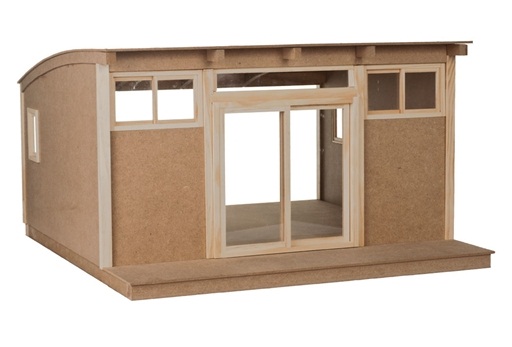
kit photo from miniatures.com The idea behind the build is making a barn find diorama. Here are two great examples of the look I’m going for: a 1961 Jaguar E-type and a 1952 Barn Find Cunningham C-3 Coupe #5209. Barn finds can be quite sad looking at first sight but turn into cash cows and museum gems. I love this Charger, too, though so I am sure I will fluctuate between a before and after barn find car. :]
I named this build Milo Valley Farm after a dear hamster friend, Milo.
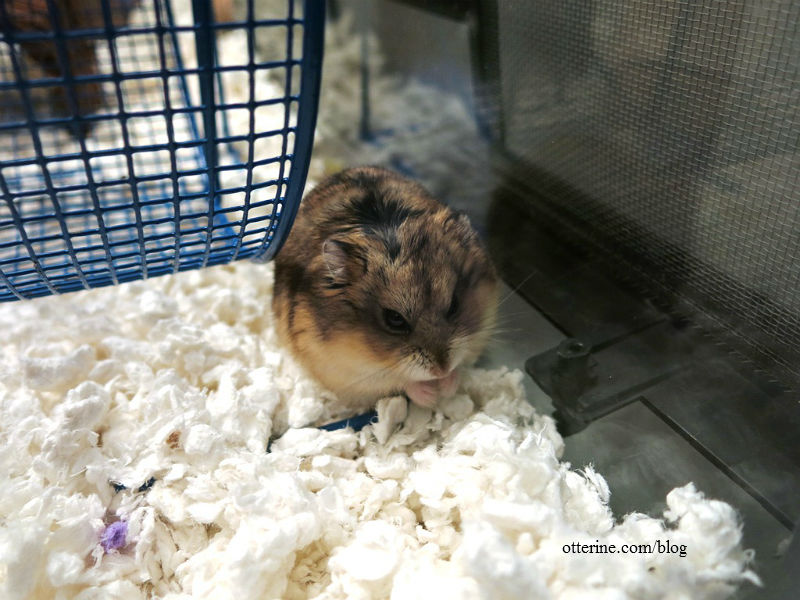
I’ve made the structure narrower but added to the depth.
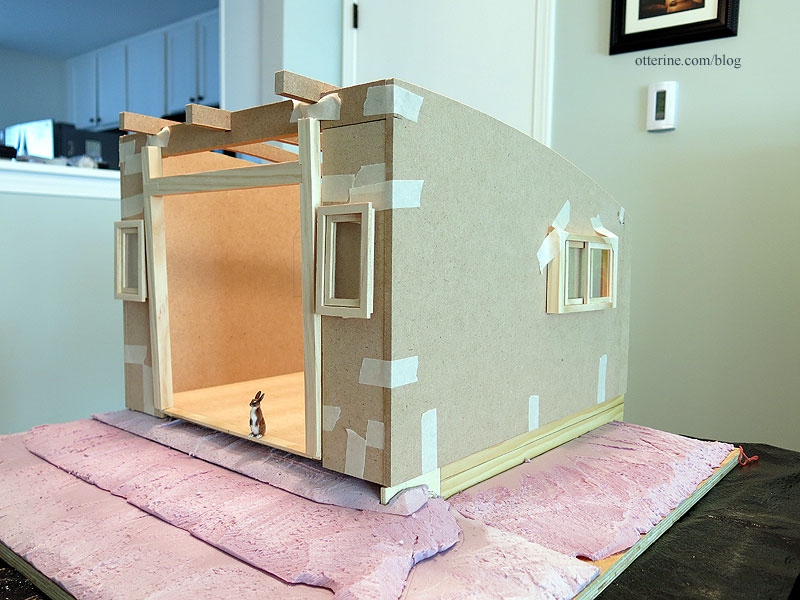
I made these changes to accommodate the 1:12 scale Tamiya Datsun 240ZG.
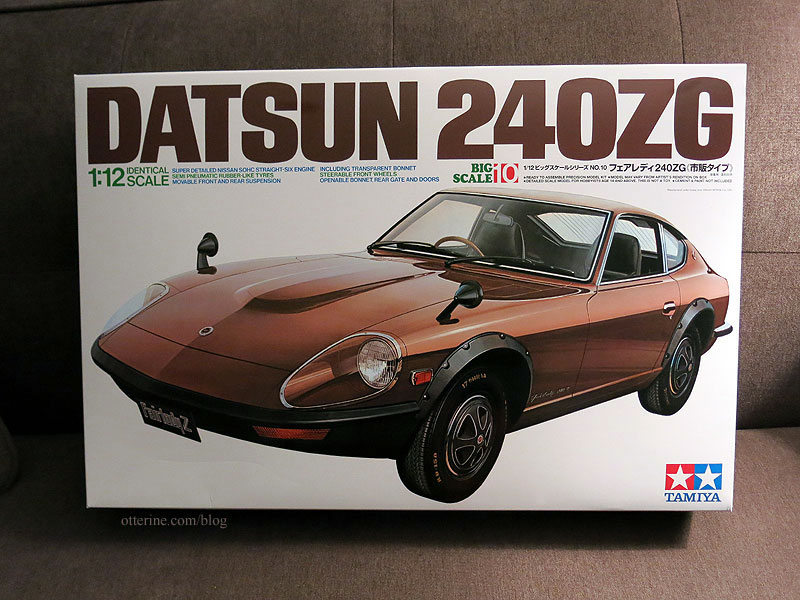
The car is a work in progress beyond the end goal of making it a barn find.
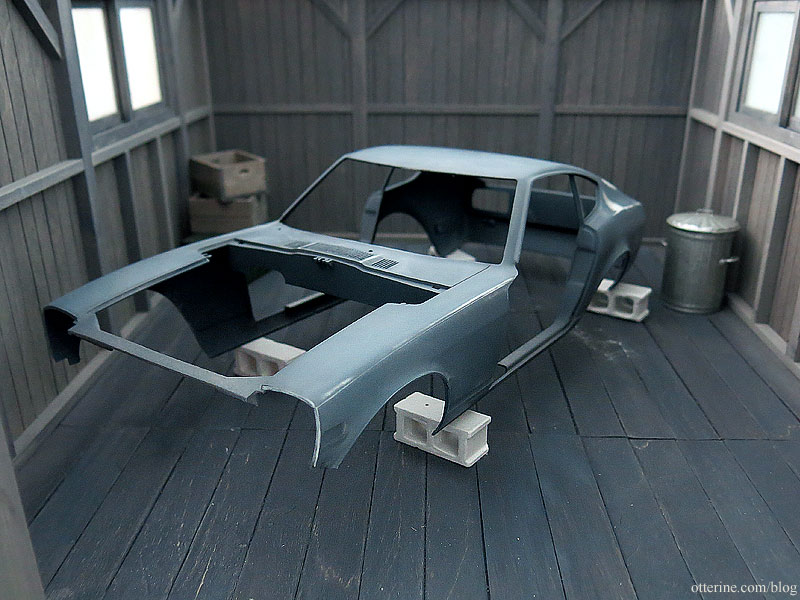
It’s an incredibly detailed model.
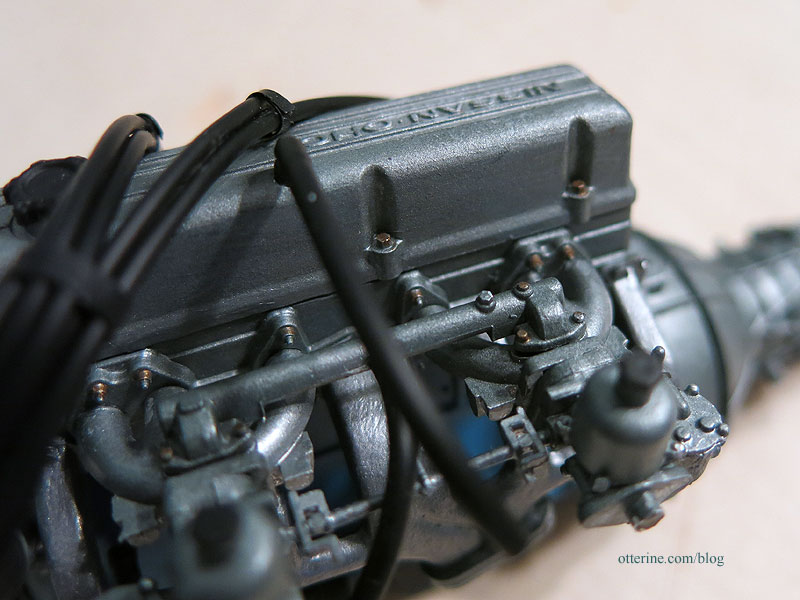
I added a taller foundation and used builders foam for the main landscaping base.
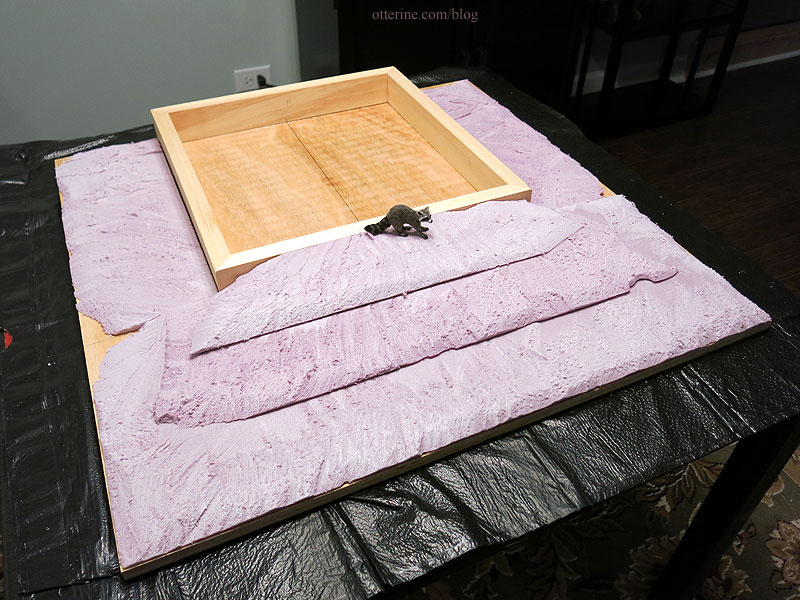
The foundation is covered with aquarium pebbles and stucco patch.
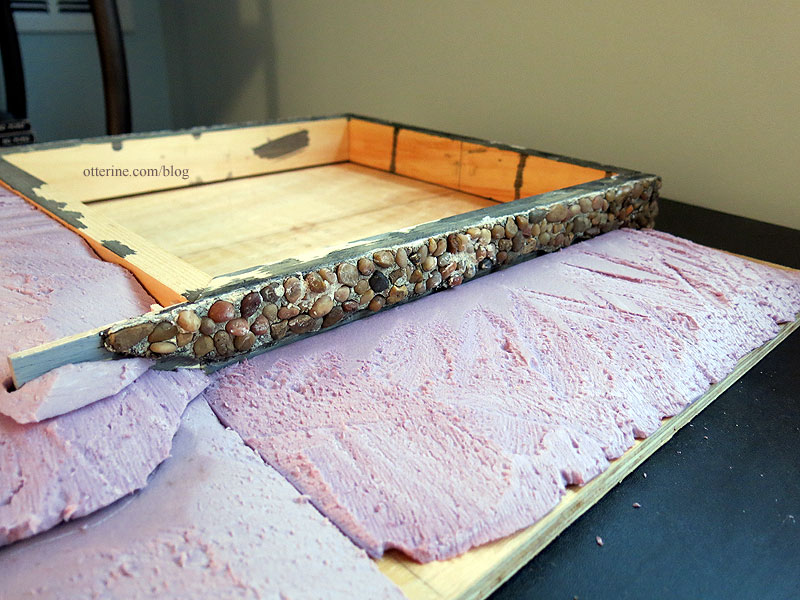
The siding was applied using templates. I added nail hole detailing and aged the wood.
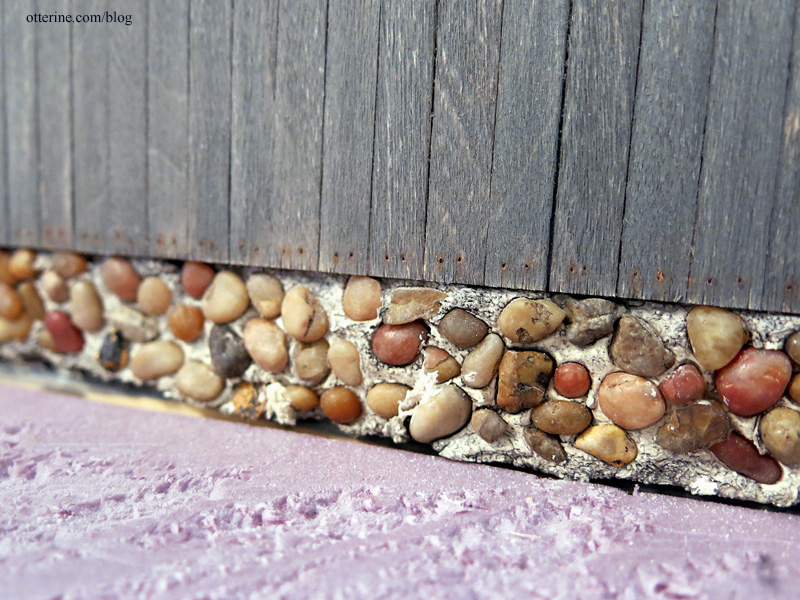
There’s a removable wall to enclose the back. The handle is disguised as an old bar used to tie up horses.
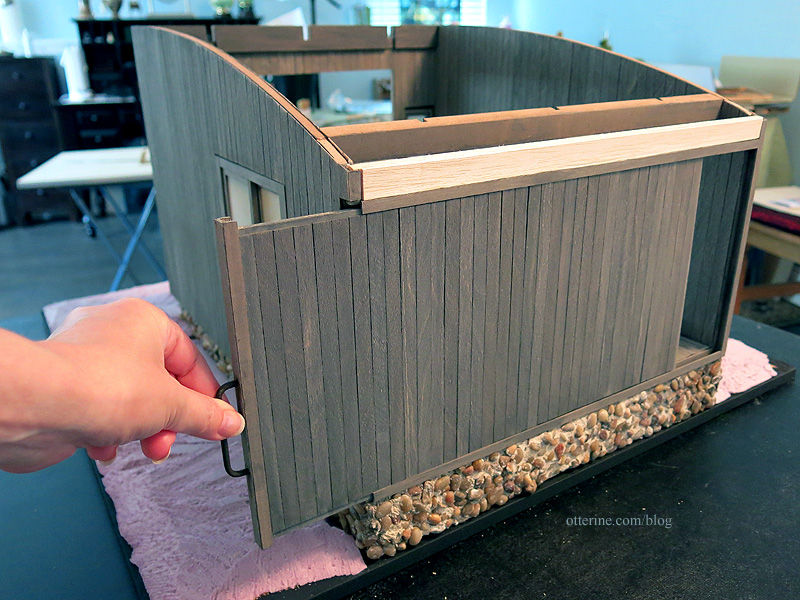
I made a black paper template of the floor. This is the same material used for the siding but left full width. I used the same painting technique as I had for the siding for the base color. I applied a few dark washes to age the planks, even dropping some puddles in places to make stains. These were lifted and reapplied a few times over. I added wheel marks and residue rings from cans that have leaked. I will add more later on during final finishing.
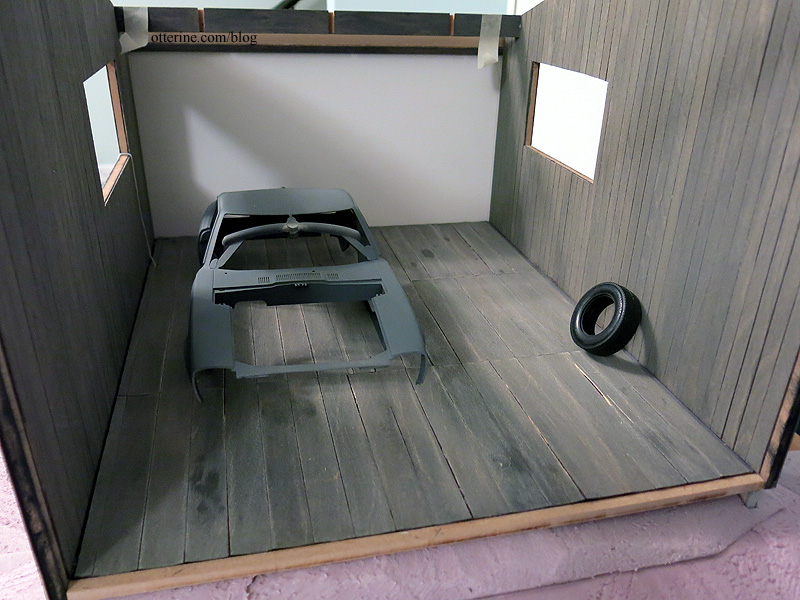
The windows come already assembled, so they required some disassembly for finishing. I used the same painting technique as I had for the siding to finish the frames. I then aged the clean acrylic inserts to cloud the glass, reduce the shine and add some color depth to the dust. You can always add more, but too much paint will look like…well…painted glass. :D These windows will be seen from the inside and outside, so I went with a lighter color to simulate dust.
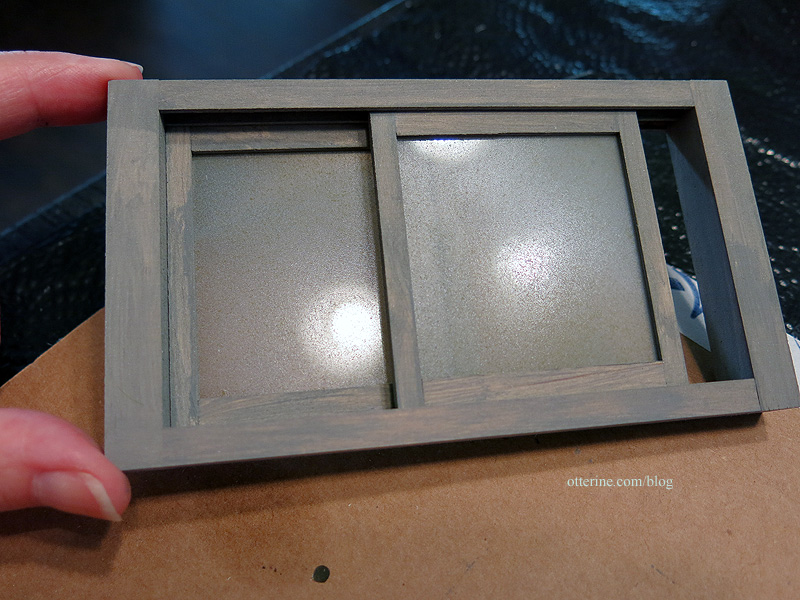
With the windows and flooring installed, I could address the interior structure. This is by no means meant to be a precise carpentry replica. It’s meant to disguise seams and give the illusion of a structured barn as well as provide a way to hide the 12V wiring system.
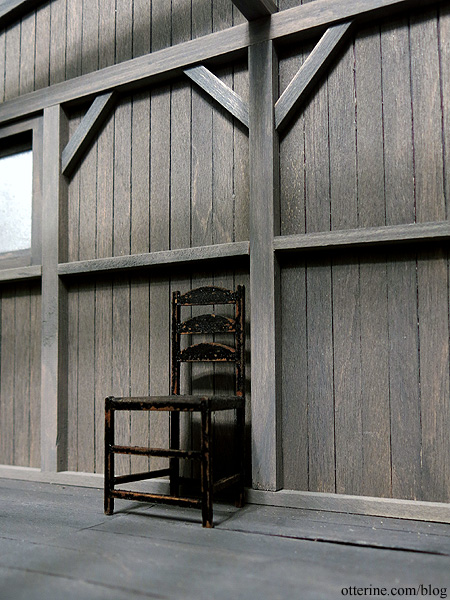
The barn has a faux knob and tube system made from plastic tubing, plastic rod, crochet thread and copper headpins. I mapped out the course of the knob and tube with sewing thread to work out any issues before installing the real deal. Below is the real deal.
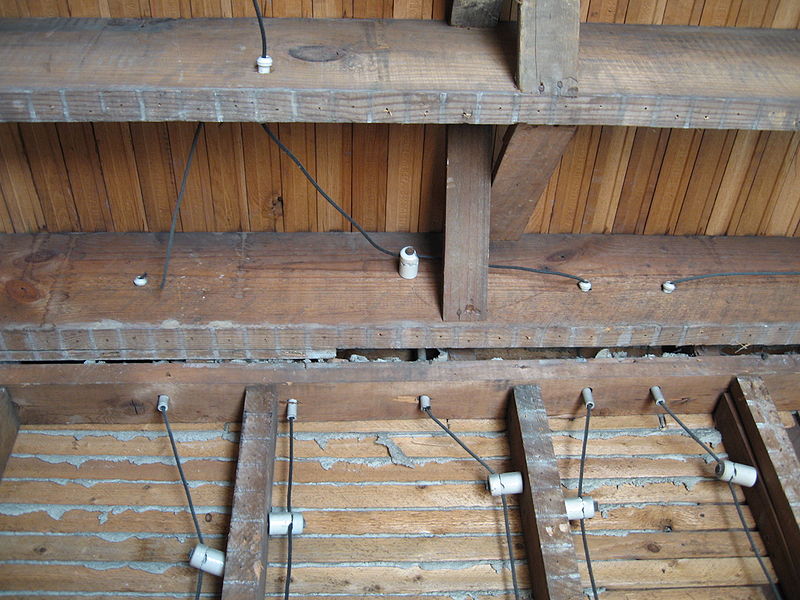
image from Wikipedia Much of this exposed work would have been done with cleats instead of knobs, but I like the look of the knobs and perhaps the builder just used whatever he had the most of in the old barn.
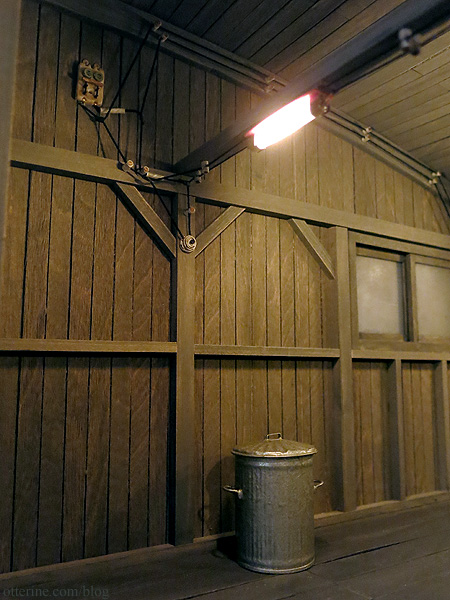
I led the wires down the wall to a key switch (made from a bell push from Sussex Crafts and a wood disc). A lot of this was guesswork since much of the knob and tube wiring examples I found are modern inspection photos of improper splicing with modern wiring. But, I think I managed to capture the essence of it, no?
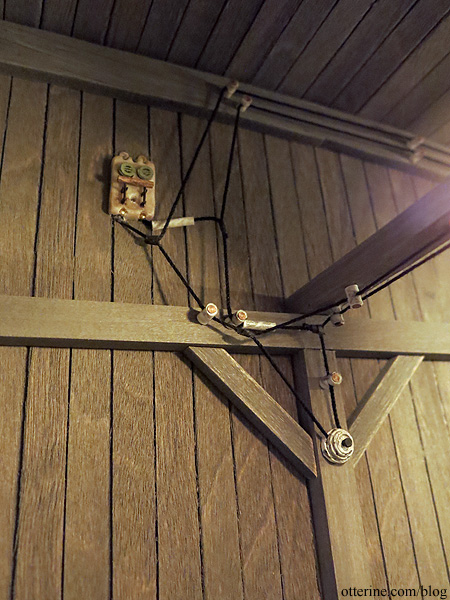
I made the porcelain fuse block for the service entrance from polymer clay (Sculpey in Pearl) since it was easiest to mold and shape and would look enough like porcelain to pass. I used jewelry findings for the connectors. The fuses are made from brass and silver watch parts (painted) and two clear plastic discs. The switch doesn’t pivot; it’s glued in place.
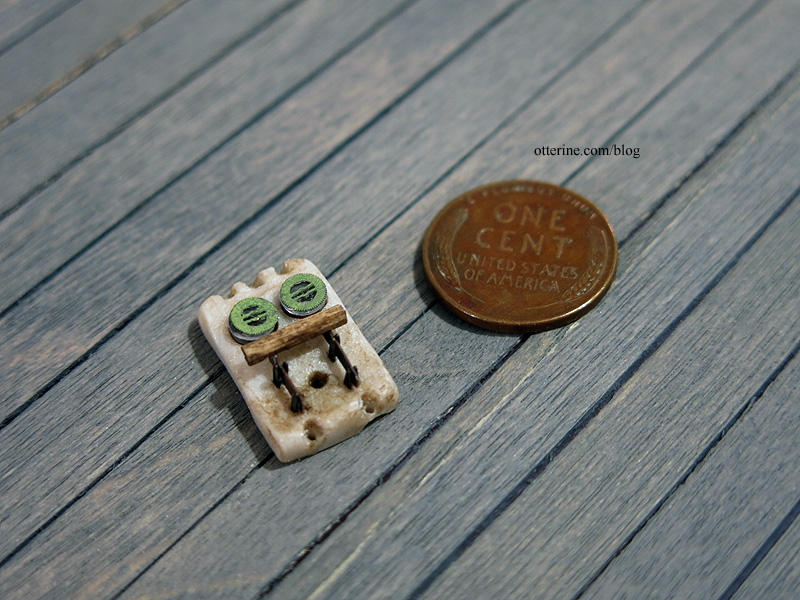
The actual 12V electrical system is hidden in the channel molding that forms the beams and posts.
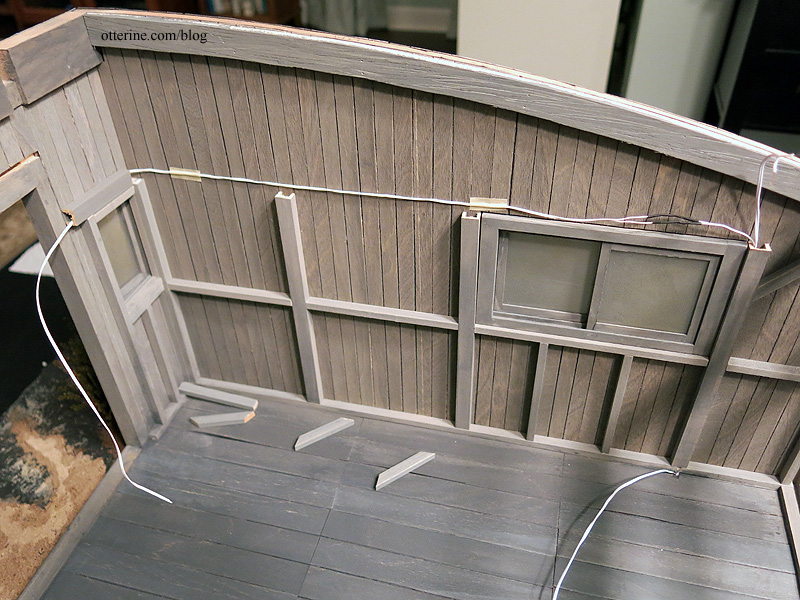
The old barn light was made from a Meyers Wall Light. I brushed on flat black paint to remove the gloss shine. Once that was dry, I dry brushed on dark brown to make the finish appear corroded and dirty. Since the door frame sticks out, I added a square of scrap wood to serve as a base for the light. Just a few modifications, and it looks like an old barn light that’s been there a long time.
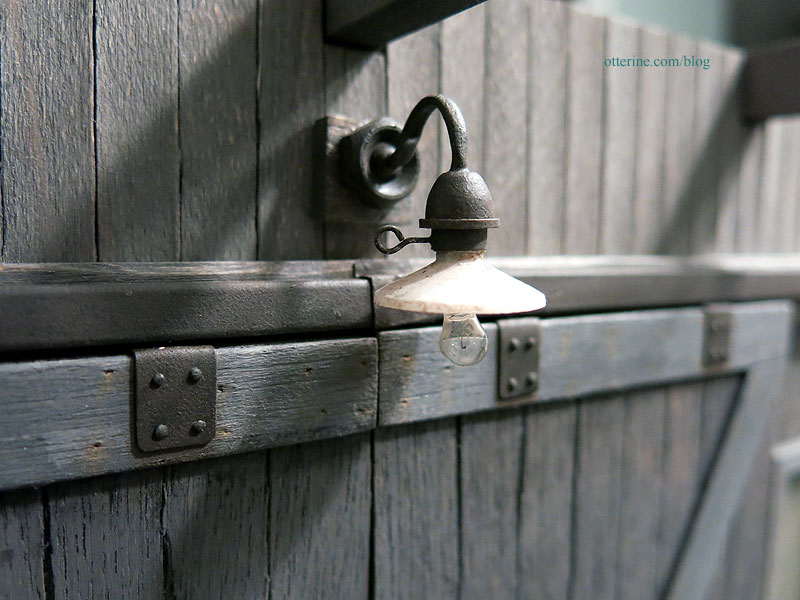
There’s a receptacle inside an old sea chest. The wiring leads out through the foundation and is covered by the landscaping foam (that process here).
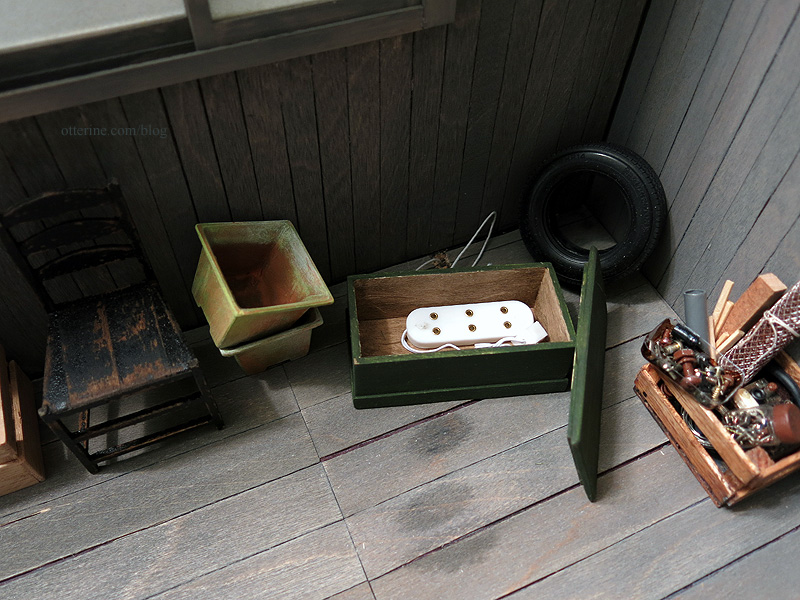
The 12V lighting features some new old stock E-Z-Lectric light fixtures from ItsyBitsy Old Stuff. These are great since they already look a bit aged; a few of the bulbs show crackling in the frosted glass finish.
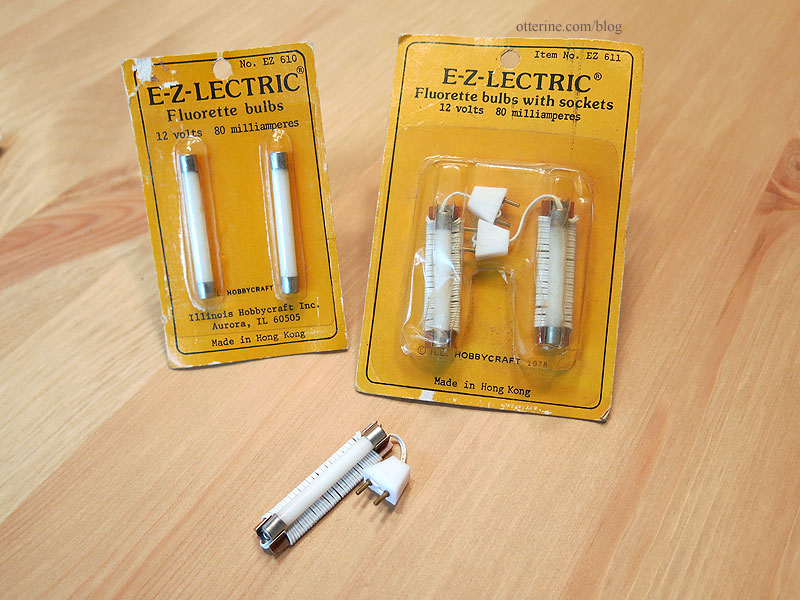
They provide the perfect amount of old, yellow light for the barn.
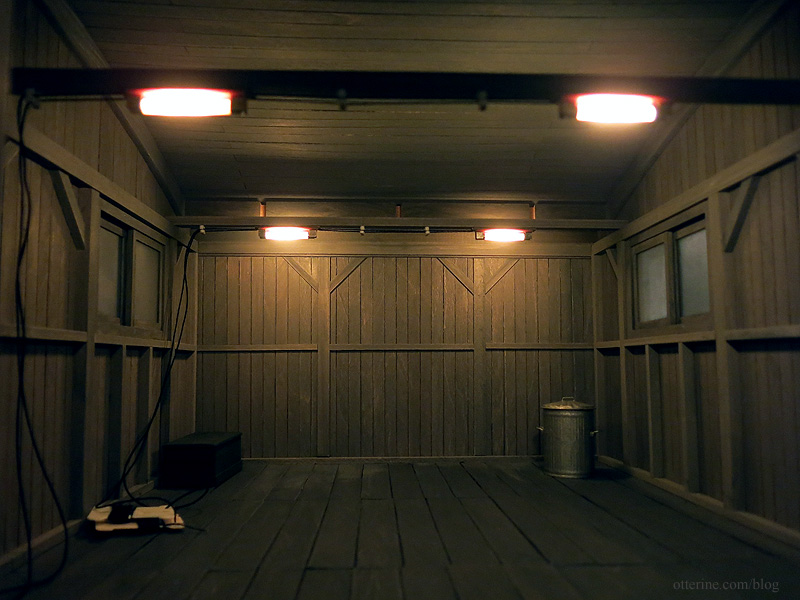
The old electrical pole was made from a 1/2″ wooden dowel cut to a proportional size of 16″ tall, not exact scale. I took into consideration the fact that the wires need to clear the barn door to reach the tubes on the side of the barn.
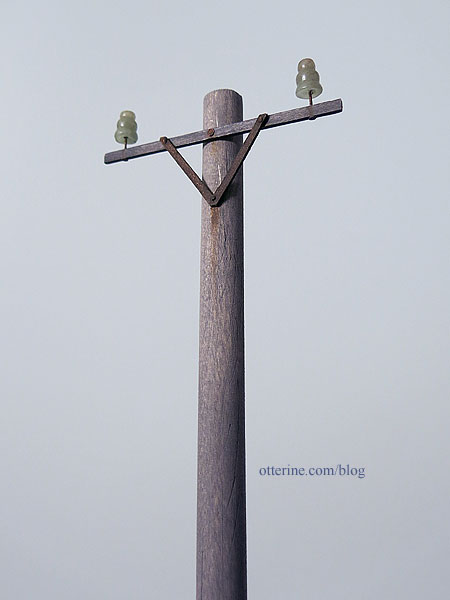
I cut the cross bar from basswood, painted and aged before assembly. The v-shaped stabilizer was cut from cardboard and painted to look like weathered metal. I used metal headpins and tiny brads for stability and nail detailing. I glued green adventurine cone beads onto the side wires and added aging washes. These are as close to mini glass insulators as I could find.
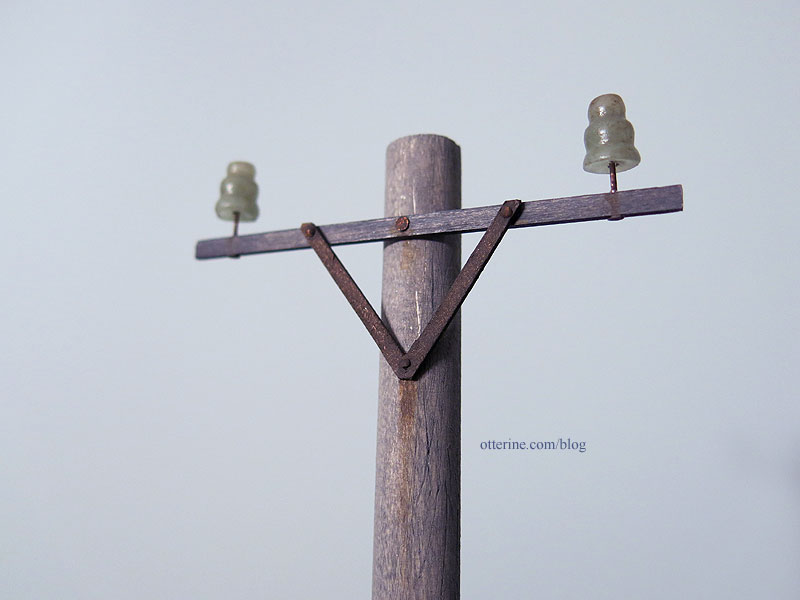
I cut the roof board down since I had narrowed the building. I had to cut an additional piece for the back since I had made the building deeper. Interestingly enough, I ended up with an extra roof board since the one that came with the kit originally was damaged so I had enough to cut the extra piece for the back from the same material.
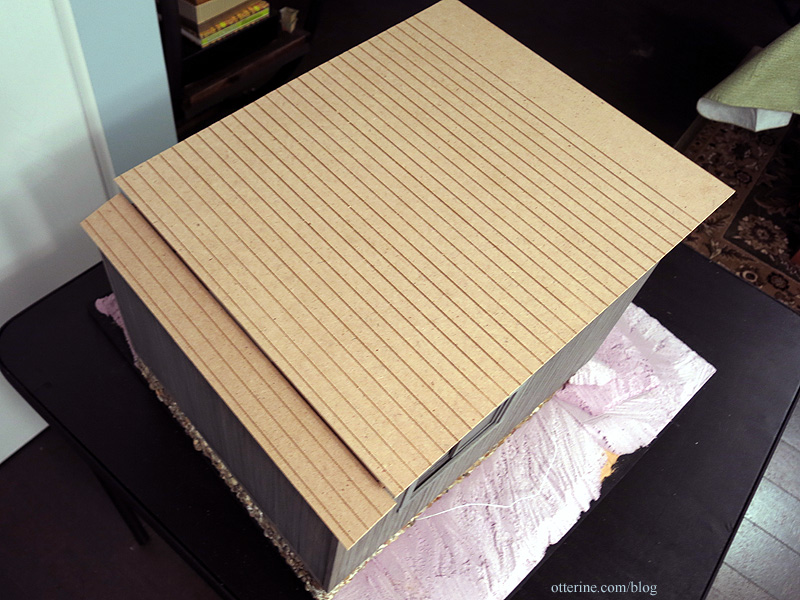
I made a template for the ceiling from black paper and used the same thin wood strips as I did for the siding to mimic a plank ceiling. I made sure seams hit where a beam would cover the gap, and I alternated the placement so it wouldn’t tend to bend along that break. I left a tiny bit of room between the boards to allow for the curve. I painted it to match the rest of the interior siding. Here it is propped in place to test the fit.
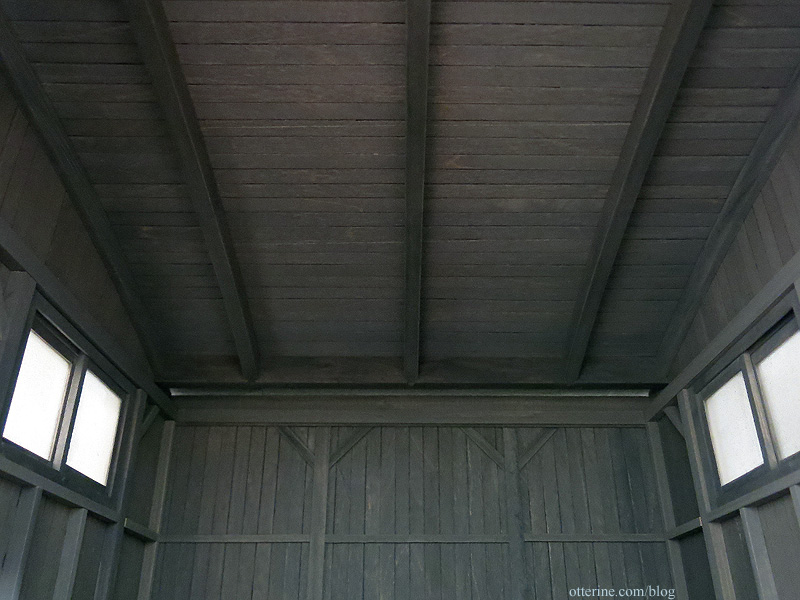
The barn doors were scratch built. I made a rail for sliding doors that extends past the end of the building on either side. I saw this setup in real life at a wedding locale.
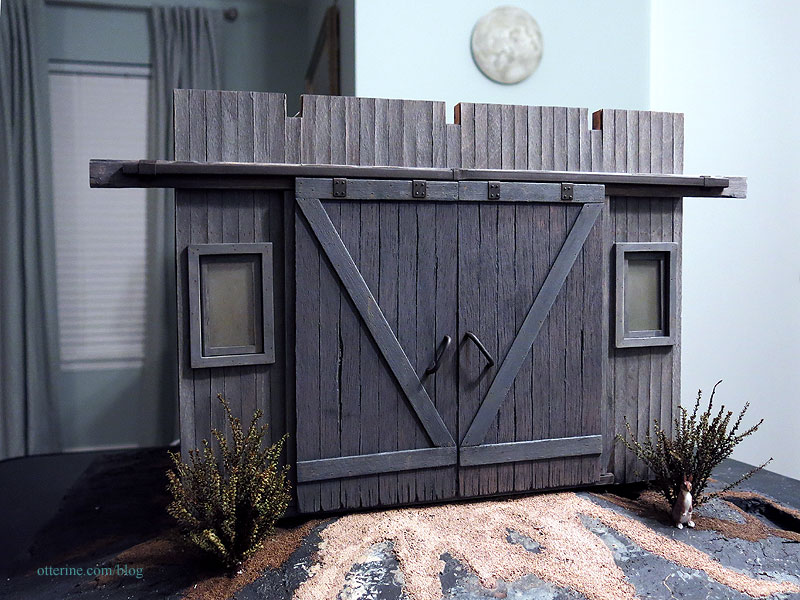
The doors can’t be moved using only the handles. I have to grip them by the sides to slide, but that’s just fine with me. I love how they turned out considering I made it up as I went along.
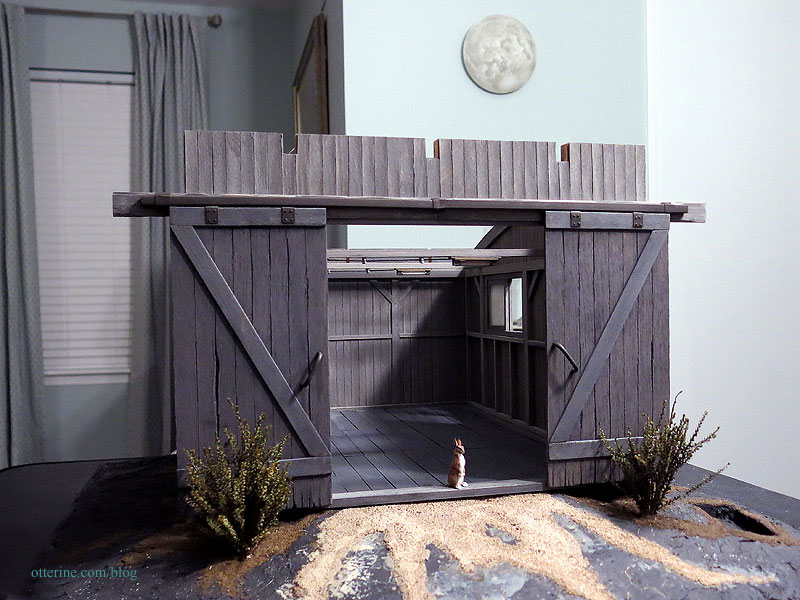
Perhaps there should be a handle inside, but…I kinda love it as is. We’ll just say there’s enough of a gap to get a hand in there to pry them open.
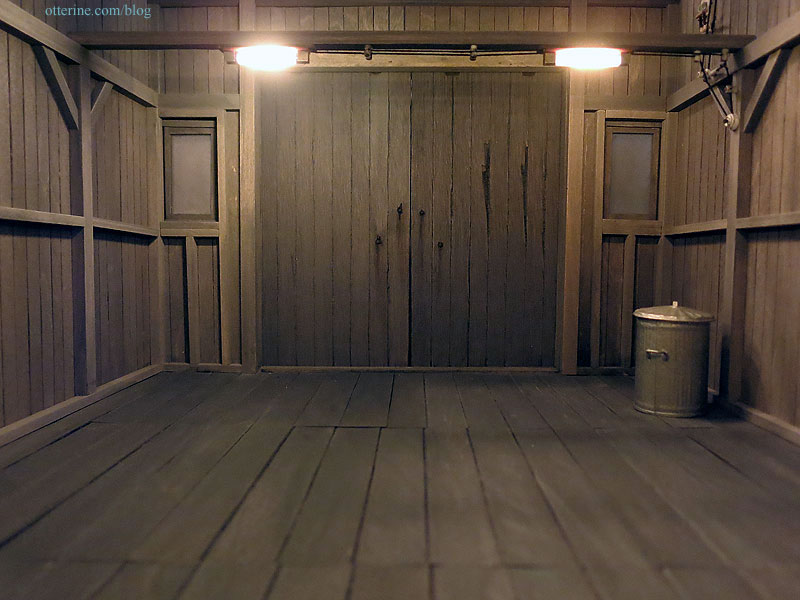
Interior Accessories
While building, I’ve taken some time to make some minis for the old barn like these 1:12 scale license plates. :D
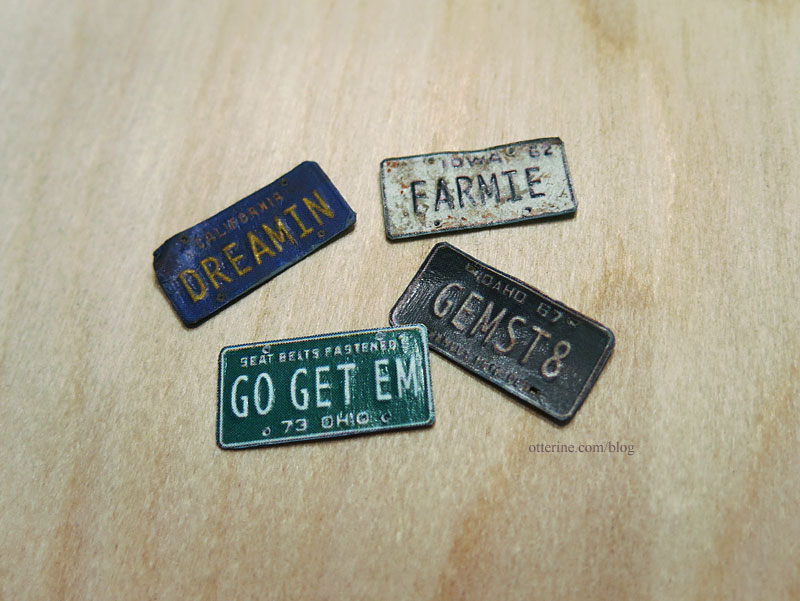
These are made from paper but look like old worn metal and even have the embossed detailing of the real deal.
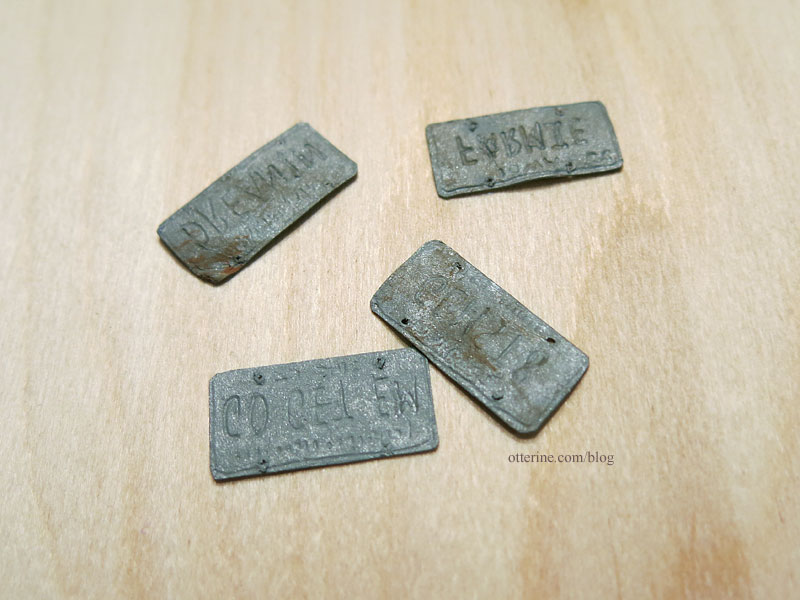
Bill sent me a whole bunch of marvelous mini tools that he made.
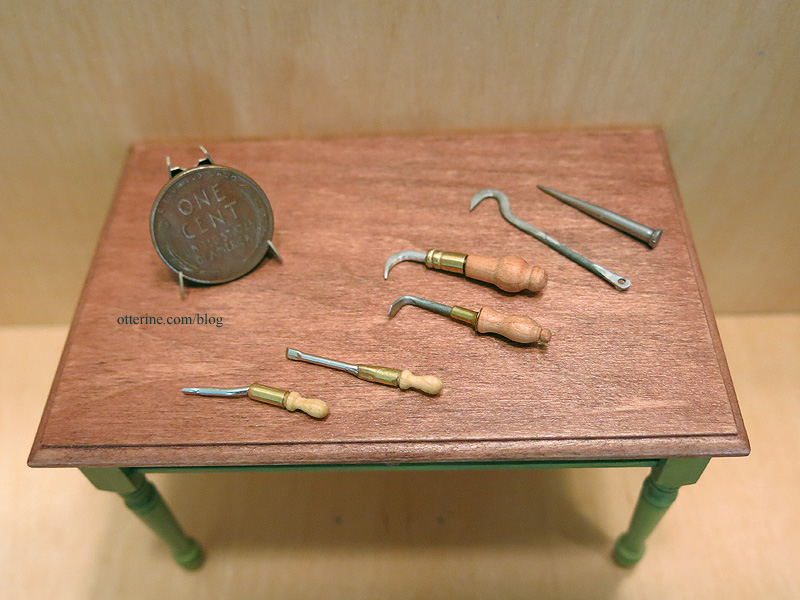
I’ve made a few items from a 1/12 scale Tamiya tool set. The vintage Texaco jugs I found online were all red, but I liked the white on the kit box, so I stuck with that.
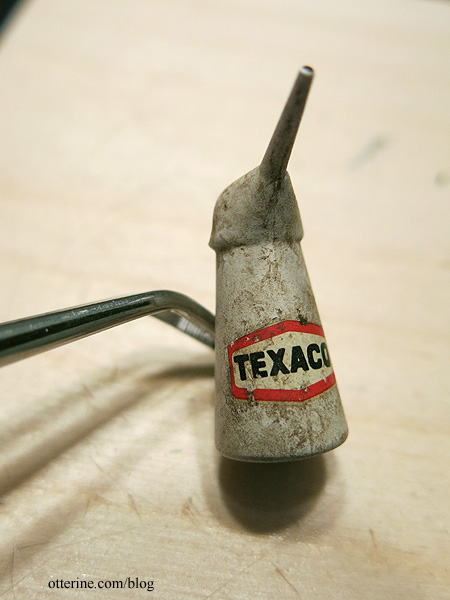
For the polyethylene tank, I added the same grime and painted the cap red. One of my favorite details is the dribble of dried liquid down the side.
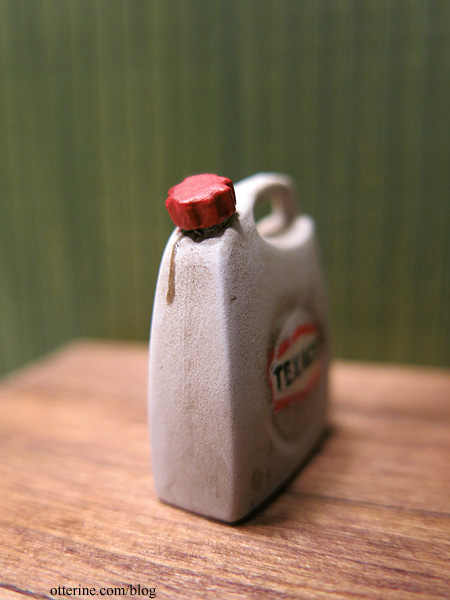
I can’t take credit for the sign other than the discovery at Hobby Lobby. It’s a magnet and the surface has embossed detailing. They had several kinds of old time logos and signs, but I stuck with the Texaco brand from my other accessories. No reason for the preference. It’s been an unplanned theme.
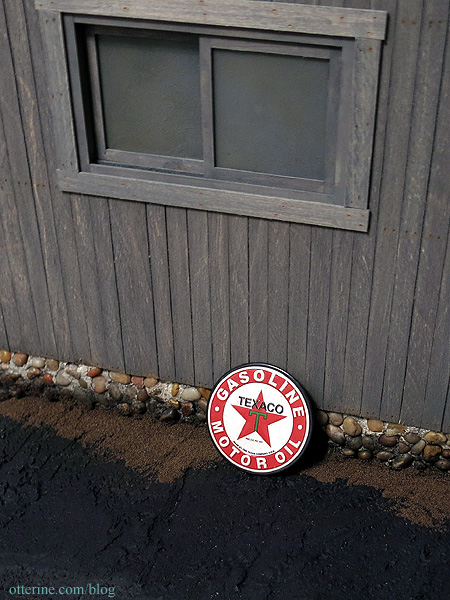
These fabulous miniature cinder blocks were sent to me as a free sample from Mini Materials.
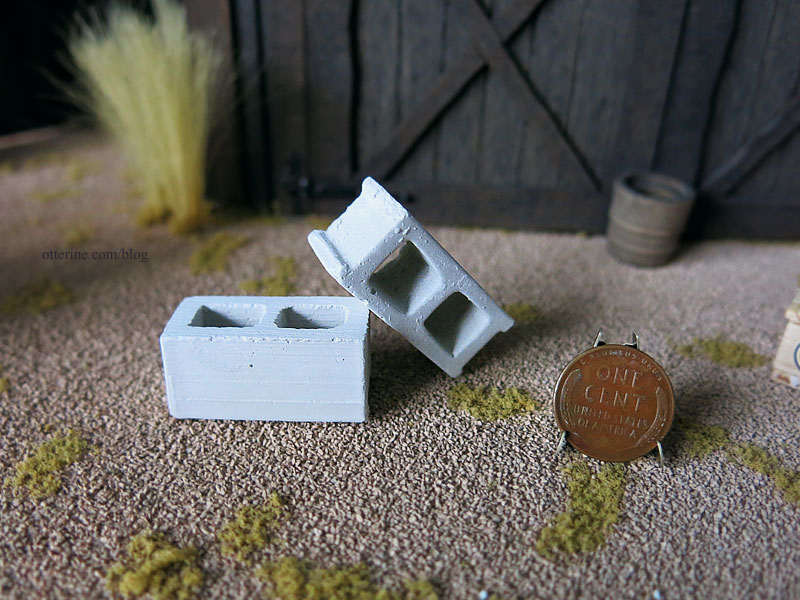
Landscaping DetailsThe landscaping is meant to be rural but not unkempt. I planted two greenery bushes purchased from A Little More in Miniatures at the mini shows earlier this year. They smell awesome. There is, of course, a rabbit hole. The rabbit is Friedrich, and he will live on Milo Valley Farm. He is incredibly realistic and full of personality.
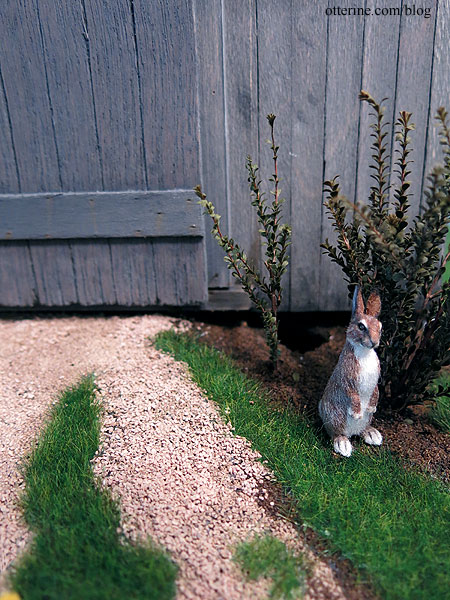
For the non-grass detailing, I added Fine Ballast Dark Brown by Woodland Scenics around the edges of the barn and used a lighter colored Woodland Scenics Ballast left over from Baslow Ranch for the disappearing ramp. The grass mat is Wild Grass in Dark Green by Heki from Scenic Express (they call it Summer Green TurfGrass on their website). It has high dark green grasses with some variegated coloration to simulate a wild but well-kept lawn. Just because there’s a barn find car inside doesn’t mean the whole property has to be an eyesore. :D
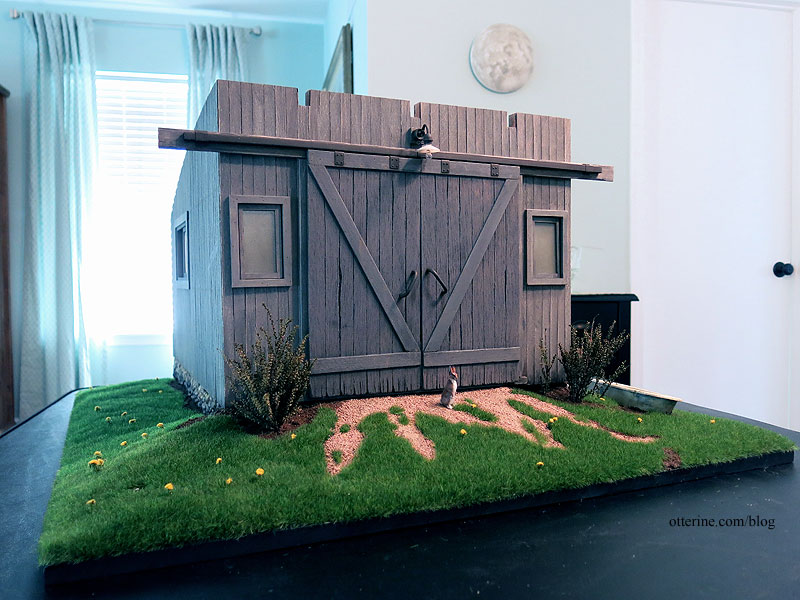
I added Goldenrod Weeds “Silflorettes” by MiniNatur. The landscaping here is spring/summer grass with a weed or two cropping up between mowing with the big riding mower.
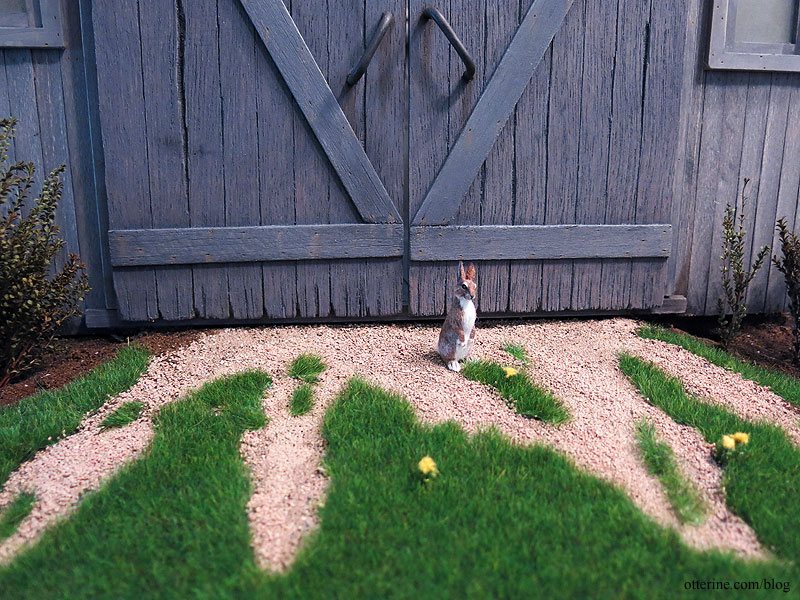
I made a delightfully disgusting abandoned bathtub to plant in the landscaping. This is a Chrysnbon plastic tub painted and aged. Herbert the frog is by Amanda Skinner.
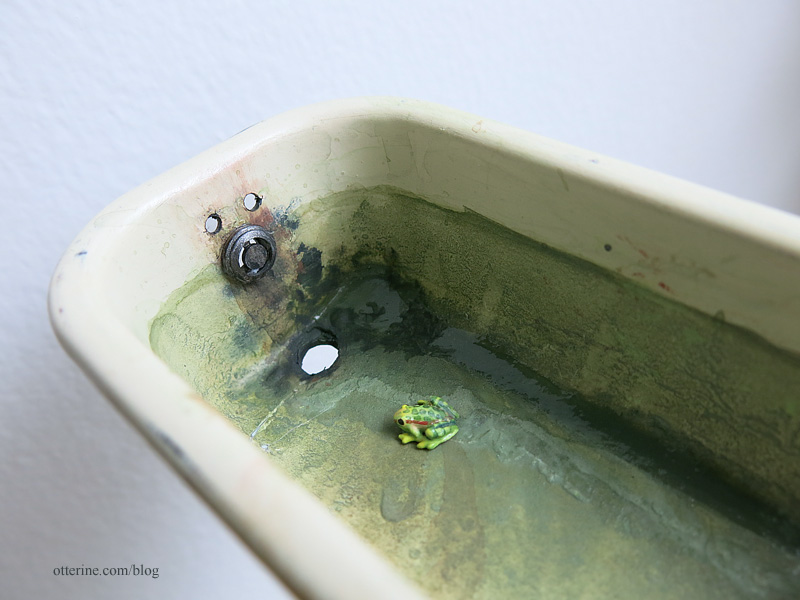
I love that the tub looks like heavy cast iron that’s seen better days. :D
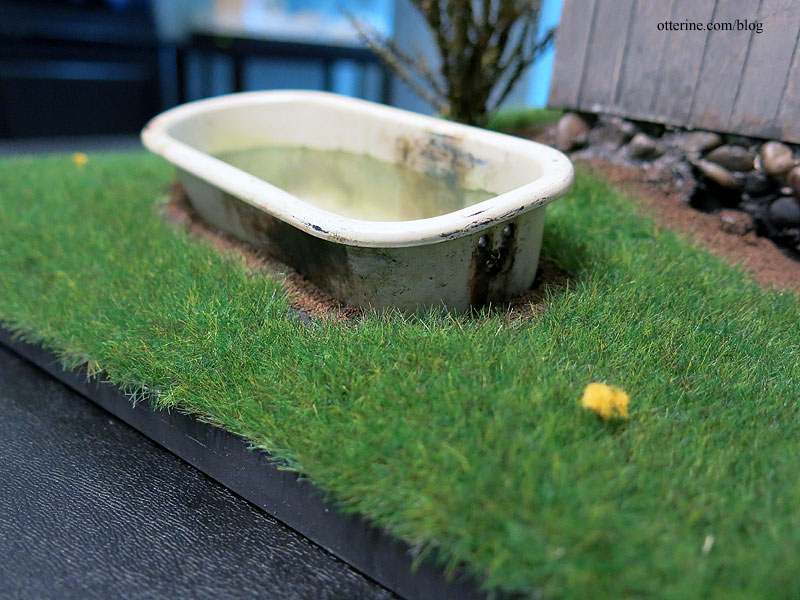
Looks like our weedy bush is proliferating. :D
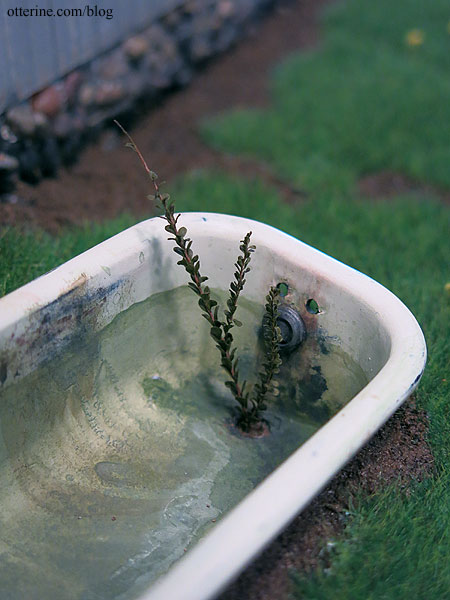
more to come…
Categories: Milo Valley Farm
April 10, 2016 | 0 commentsDatsun 240ZG – part 5 – initial aging
Continuing work on the Datsun 240ZG. The engine compartment of my barn find auto shouldn’t be showroom new, but of course the Testors Fiery Orange turned out showroom new. :\ Ah, well…easily fixed.
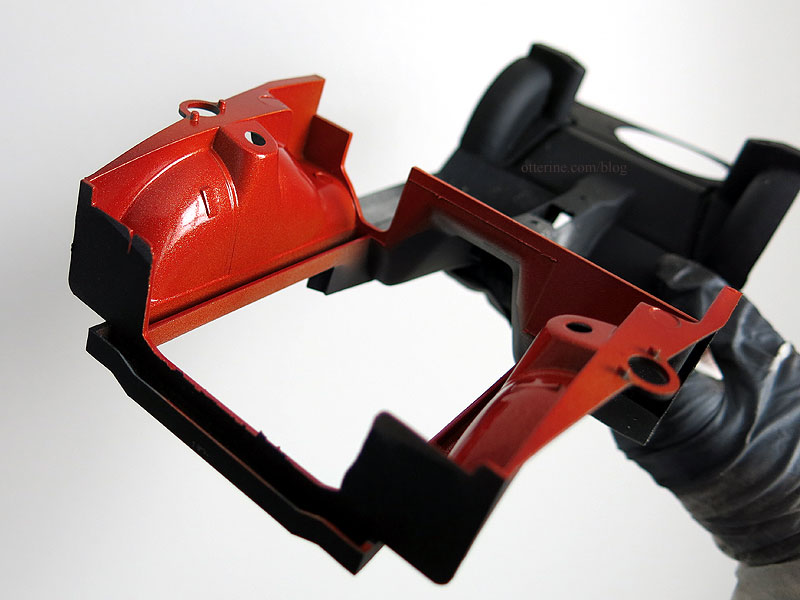
I sprayed the compartment with Testors Frosted Glass. I am sure you can use any matte finish spray, but I had this one on hand. It tones down the shine and gives the subsequent paint treatments something to grab.
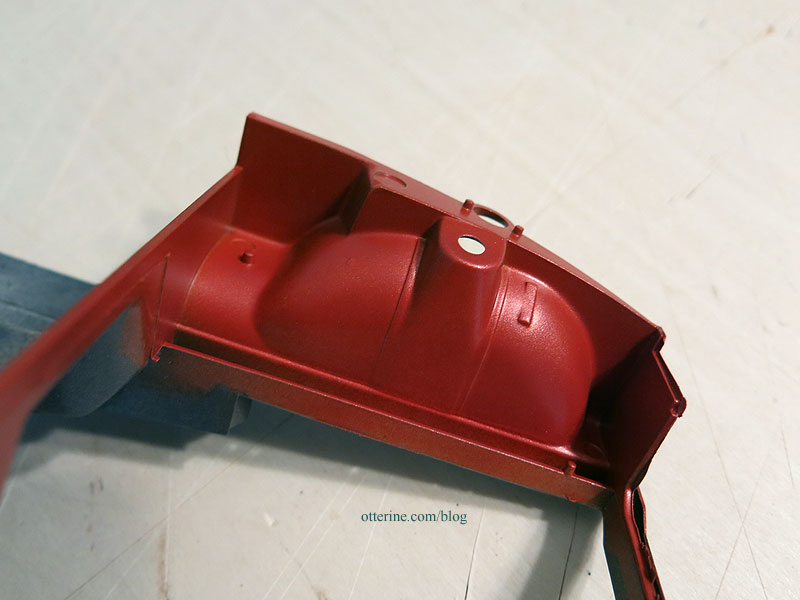
Next up, adding grime. The easiest way for me to add grime is with acrylic paint and Americana Staining Medium. I mixed blobs of browns, greys and black with the staining medium and used a variety of soft brushes.
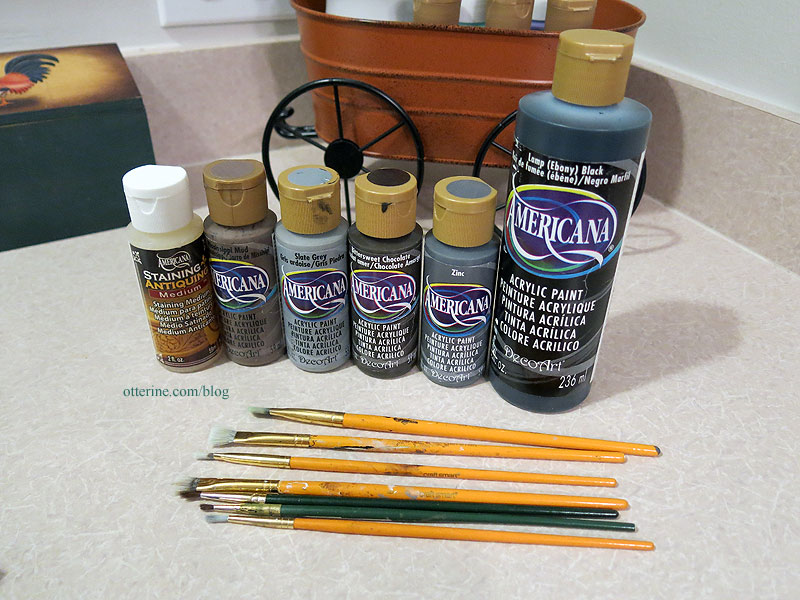
I didn’t worry about areas where parts will be glued in place since it’s part of the process to scrape those places clean before gluing anyway. The transparent stain mixtures created realistic dark areas without completely obscuring the orange body color. The staining medium adds a bit of sheen, which works well for engine grease. :]
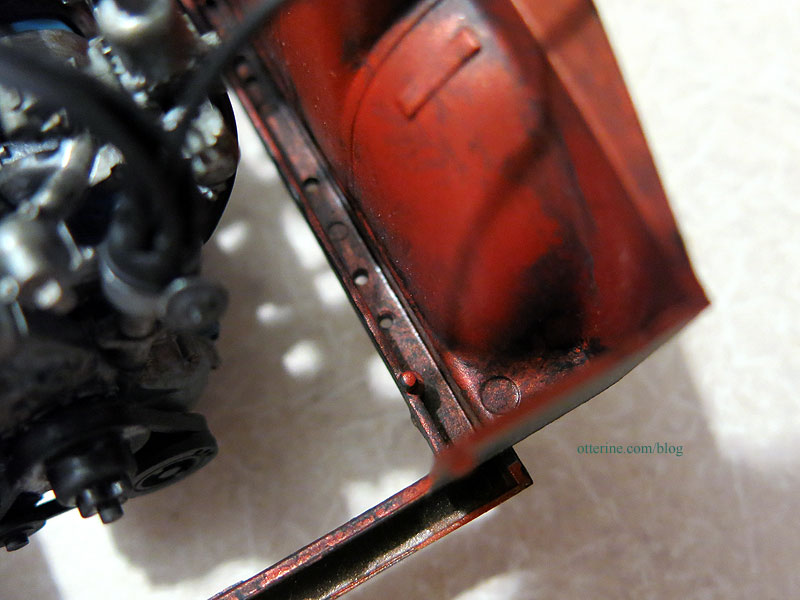
Flip it over to age the underside, turning the pristine flat black into road-worn dirt. :D Here I brushed on undiluted paint using a stencil brush, repeating the process for several layers.

This removed the smooth finish of the plastic base.
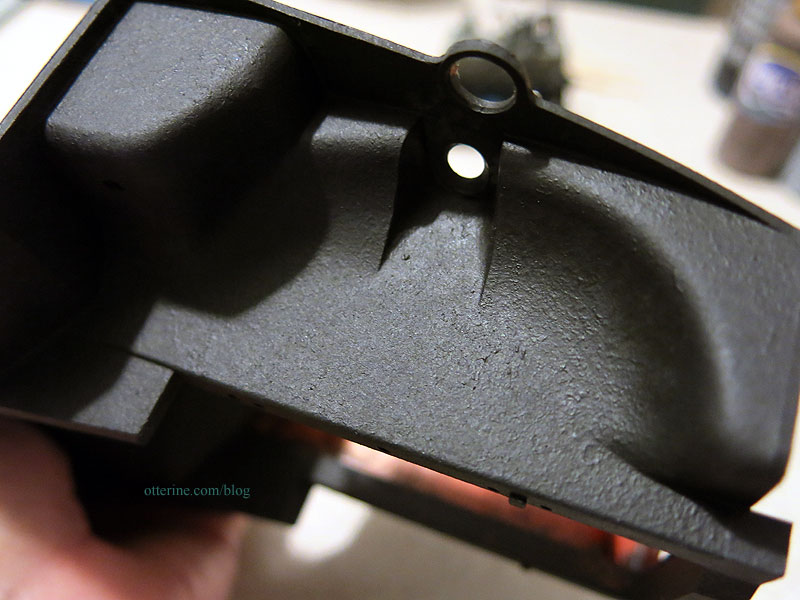
Using the leftover staining mixtures, I added a bit of light aging to the engine assembly. More can be added later, but it works in my favor to add some now while tight areas are easily accessible.
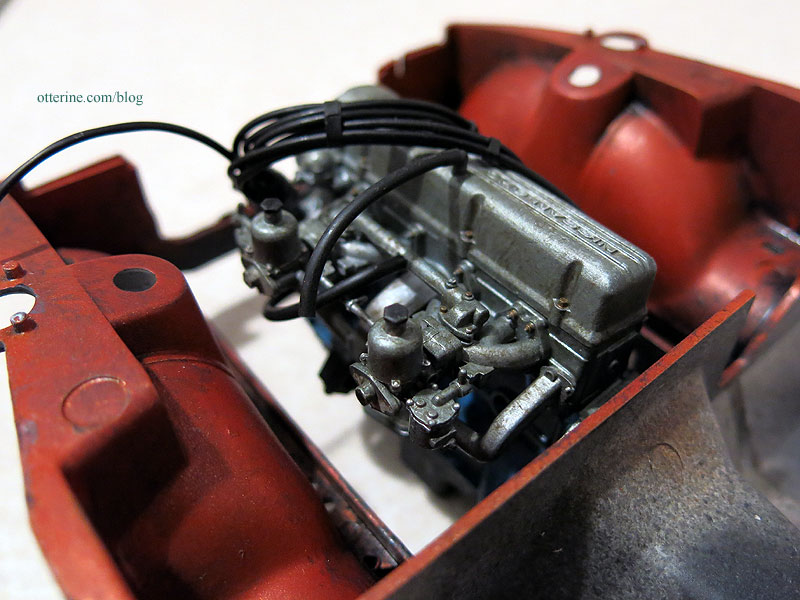
I’m not overdoing the process. I prefer subtle aging that adds depth and visual weight. :]

I started sanding and detailing the main body piece. This is an excellent model, so there was very little to do in the way of prep work, just light sanding here and there. I had spray painted the body with a quick pass of grey. This paint layer helps highlight the imperfections and excess plastic from the molding process. Cinder blocks from Mini Materials.

There’s a vent detail in front of the windshield. It didn’t take the initial coating of primer spray very well, so I decided to detail it now. Any subsequent spray-painting shouldn’t interfere with the work. I used a toothpick to drop in Testors flat black.

I wiped the excess with a paper towel.
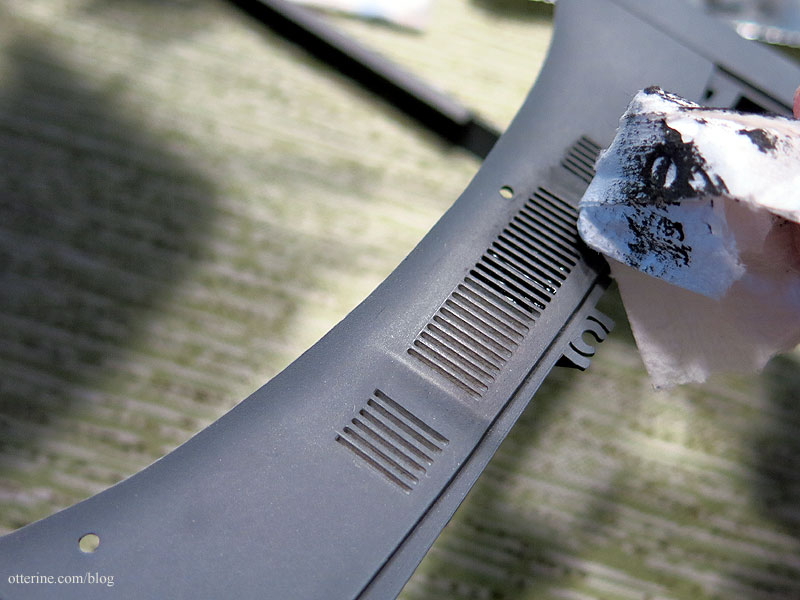
This fills the vent and makes it look like an opening in the body. I can touch up the effect after the final body color by using acrylic paint, which won’t stain the enamel color the way the Testors paint would. This is a good base to build on later.
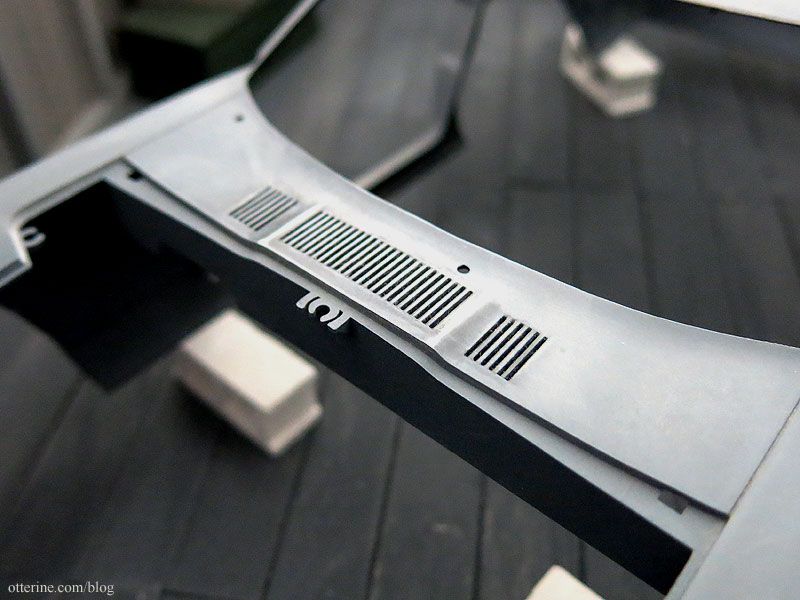
Back in the engine compartment, I wanted the washer fluid tank to look like it contains actual fluid so I spent several hours painting it. The tank isn’t glued in yet, but the holding bracket is. I needed to know the angle of the tank to paint the fluid line at the appropriate slant. Dirtying up the surface helps sell the idea. :]
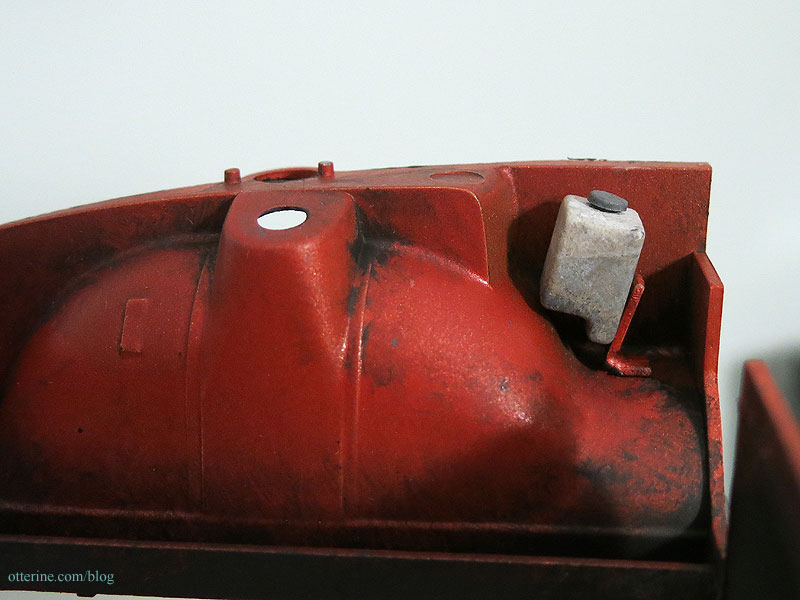
Categories: Milo Valley Farm, Model Cars, Vehicles
April 3, 2016 | 0 commentsDatsun 240ZG – part 4 – engine work
I knocked out two pages of instructions for the Datsun 240ZG this weekend! This isn’t all of the work I completed from those pages, but this is the main piece in progress.
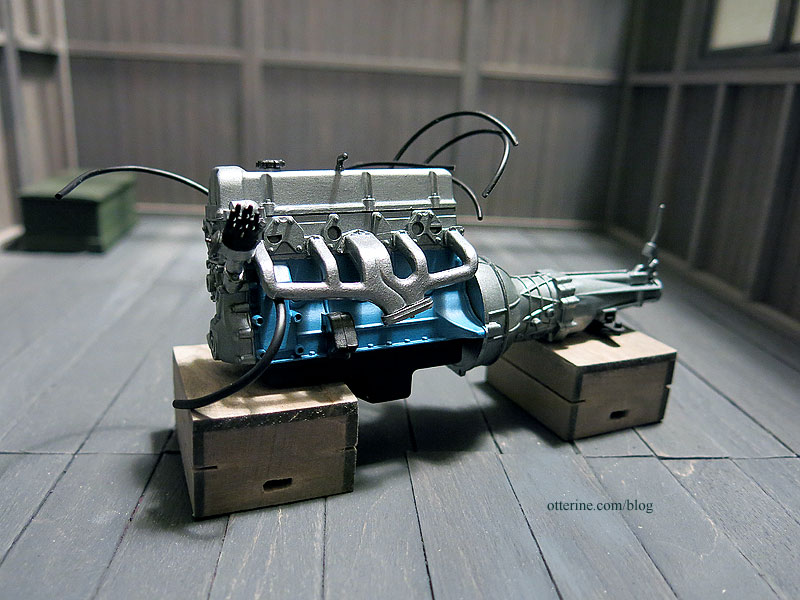
I’ve looked at some real life engine photos for color but I’ve mostly followed the instructions. Fine detailing, aging and grime will come later.
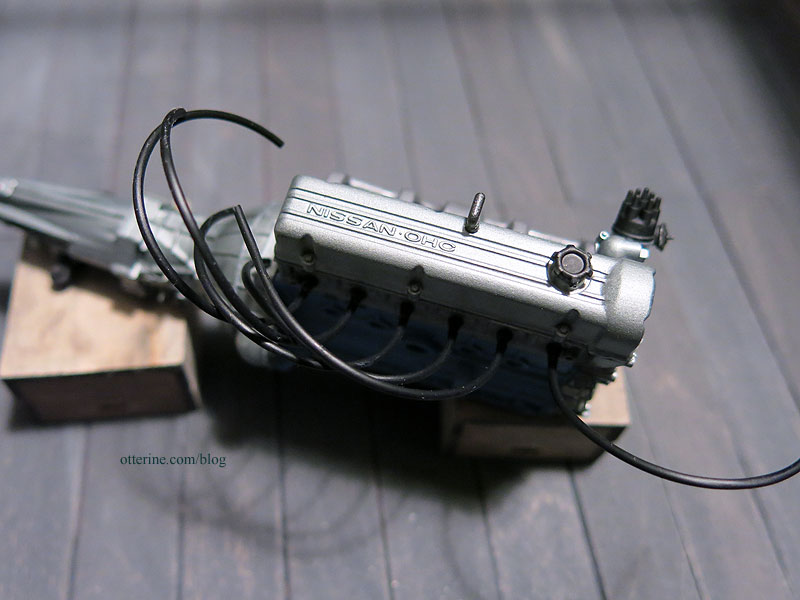
It’s coming together nicely. I added some painted detailing in the way of bronze nuts and bolts. Making nuts and bolts a different color can add realism with a minimal amount of work. I also used electrical tape to group the spark plug wires together.

I printed up some labels and decals. Yes, I filled out the “Battery Finder” form to get the right label for a replacement battery. :D I haven’t finished painting the detailing on the battery or other engine parts just yet.
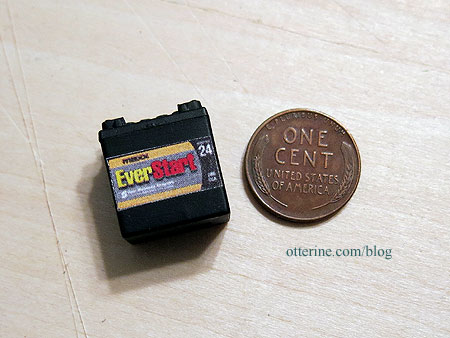
There are two for the air cleaner (love that Hugger Orange by Model Masters). I found the replica images online. I printed one of the air cleaner labels and the VIN plate (not shown) on Avery silver labels. The material gives it just enough sheen.
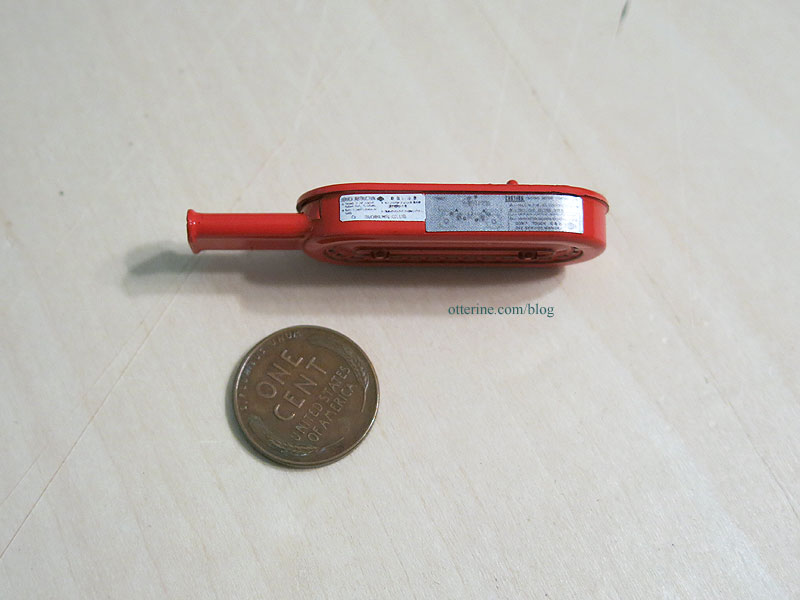
The last item was a decal for the oil filter. This was my first time making my own decals, and I love it! I will definitely do more of this in other mini situations. I used SuperCal Waterslip Decals from The Crafty PC, which is now out of business, but there are other similar products on the marketplace, including one by Testors. I can’t speak to that specific item, though I like their other products.
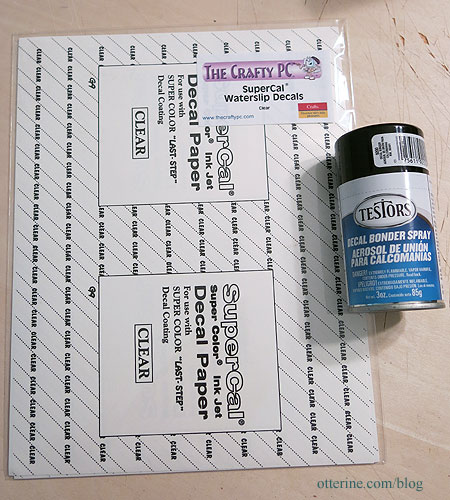
I mocked up the design using a Nissan logo and text in PhotoShop. I then printed on the decal paper. You can print along one edge and then cut cleanly across to use the remaining sheet for printing again. As you can see, I made a few at the same time to have extras in case of disaster. I also like to make a couple of sizes just in case. I ended up using the smaller one and had to make two attempts.
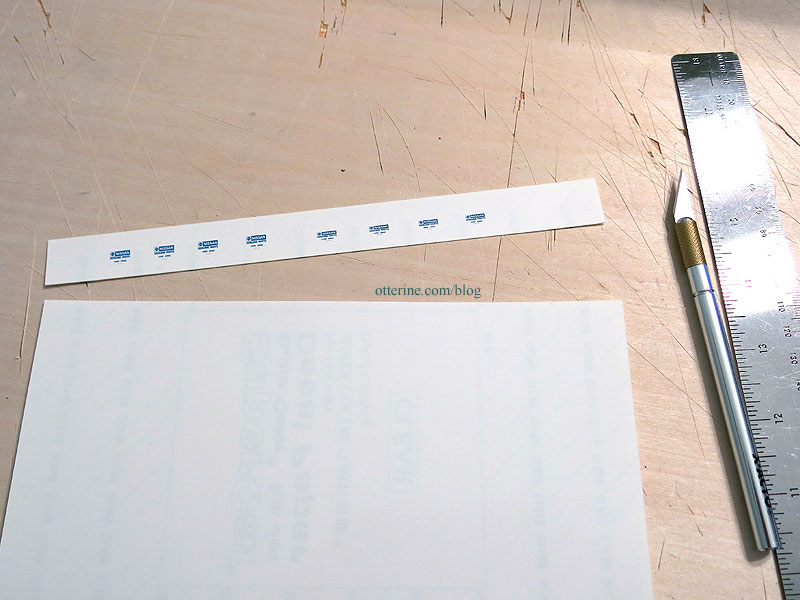
I used Testors Decal Bonder for the spray. I put on one thin coat, let it dry for half an hour. I then added a second heavier coat and let that dry overnight. I wanted something to grab onto during the process, so I cut the paper larger than I needed and scored a line where I wanted the decal to separate.
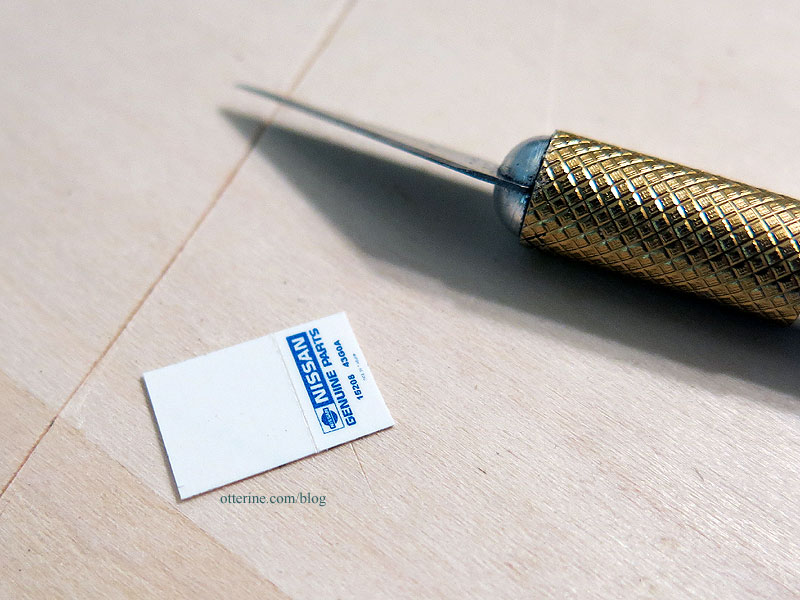
I soaked the decal for 15-20 seconds until it slipped easily.
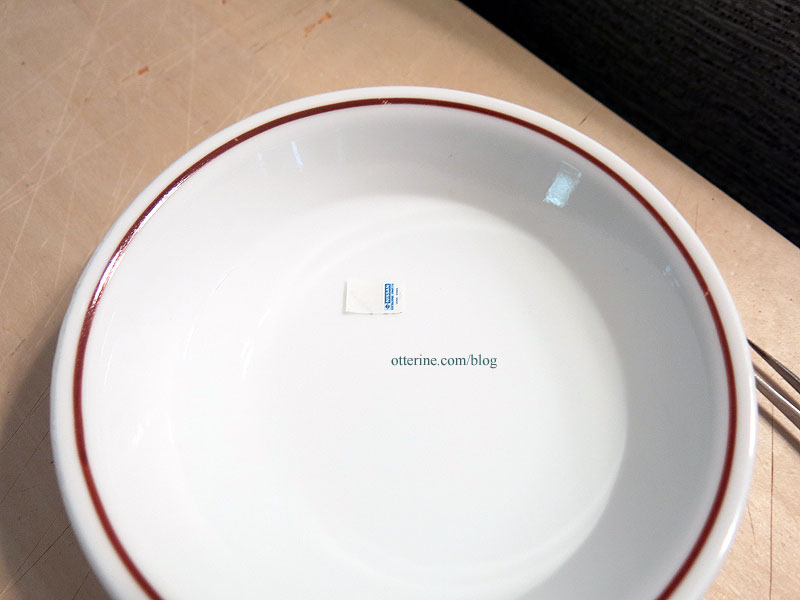
In that time, I wiped the oil filter with a Q-tip dipped in Testors Decal Set. I slipped the decal onto the oil filter and positioned it with the Q-tip. Once it was set, I dabbed it with a paper towel.
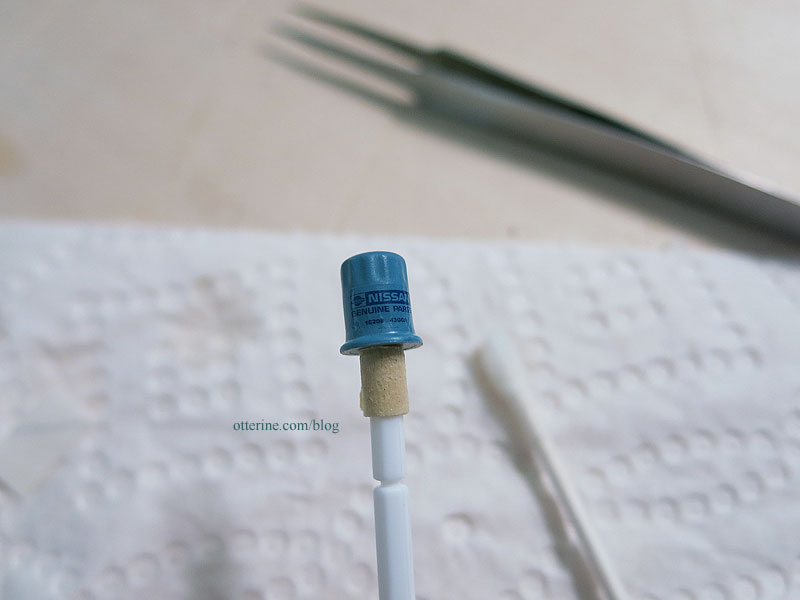
In order to remove the sheen, I sprayed the oil filter with Testors Frosted Glass spray. It was the only matte finish spray I had on hand, and it worked perfectly. Adding a decal to the oil filter is a minor detail, but it adds a lot. :]
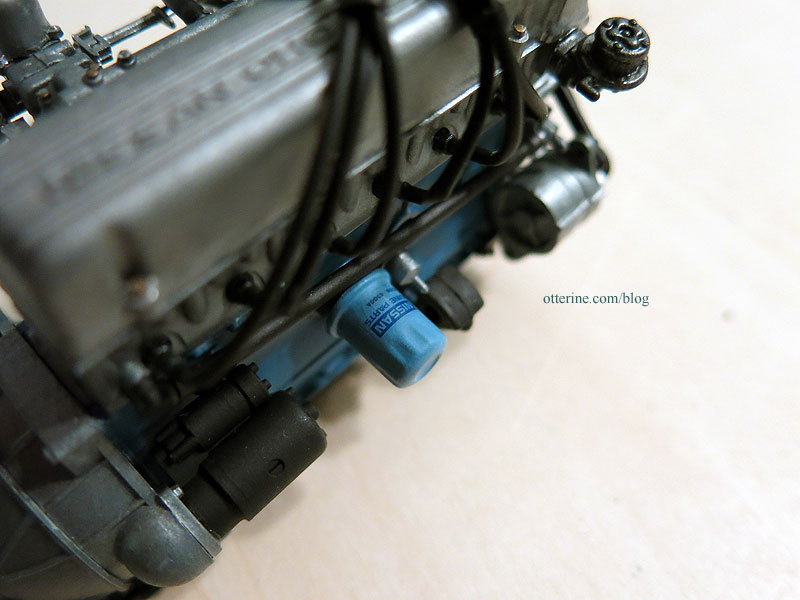
Categories: Milo Valley Farm, Model Cars, Vehicles
March 22, 2016 | 0 commentsDatsun 240ZG – part 3
Continuing work on the Datsun 240ZG. It has been a long while since I last worked on the car model for my barn find. This will be slow going because there are so many parts in general and many of them will be functional parts. I’m also in no rush and want it to match my vision. These sorts of projects are not for the timid. Now I’m back to building, one step at a time. I’m still on page one (of 13).
I don’t know if any of you will build a model car, but I like to share tips in case someone stumbles onto my blog. Or, perhaps the tips will apply to other situations. One of the things I’ve done for this build is to mark tiny plastic bags to hold assembled parts when I have to know front, back, left or right. I also mark them with the step number so I can easily find what they are when needed later. There are a lot of smaller assemblies that get pulled in later, so it just makes sense to mark them and protect them as I go (I’ll worry about touch-ups later).
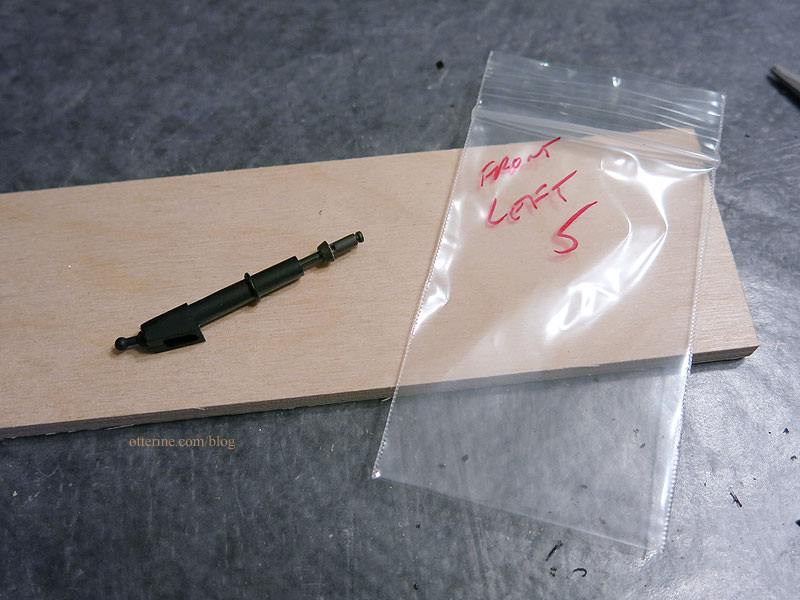
The other tip I have is removing that gleaming chrome finish from plastic model parts. There are several videos on the matter, and the easiest method involves household bleach. I stripped the bumper and the shock absorber parts mainly because I’ll be making the underneath a little aged and well used. Beyond that, the chrome bumper just looked like chrome coated plastic. :\ I will paint it to match the front bumper, which is grey metallic.
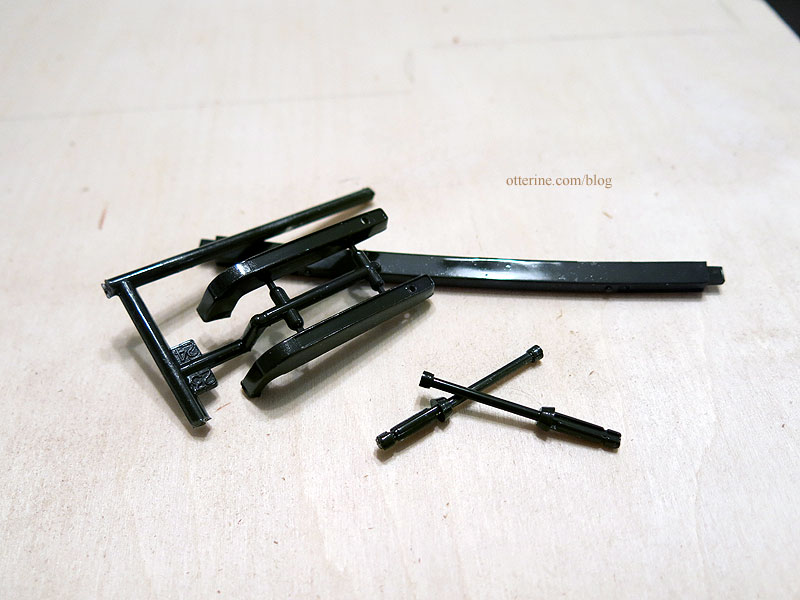
I watched the chrome disappear during the process, and the color went from high silver to yellowish to absent. This gave me an idea for the chrome wheel caps. =bling=
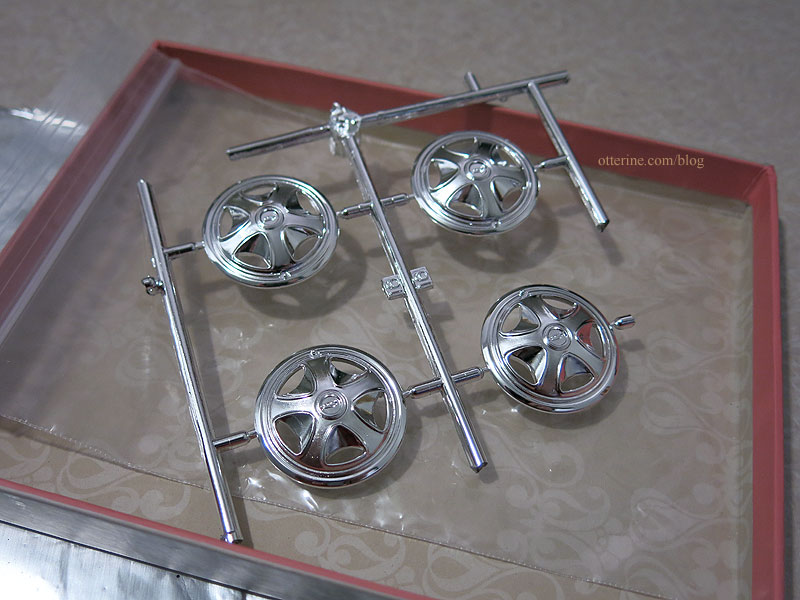
I soaked them until they turned slightly yellow.
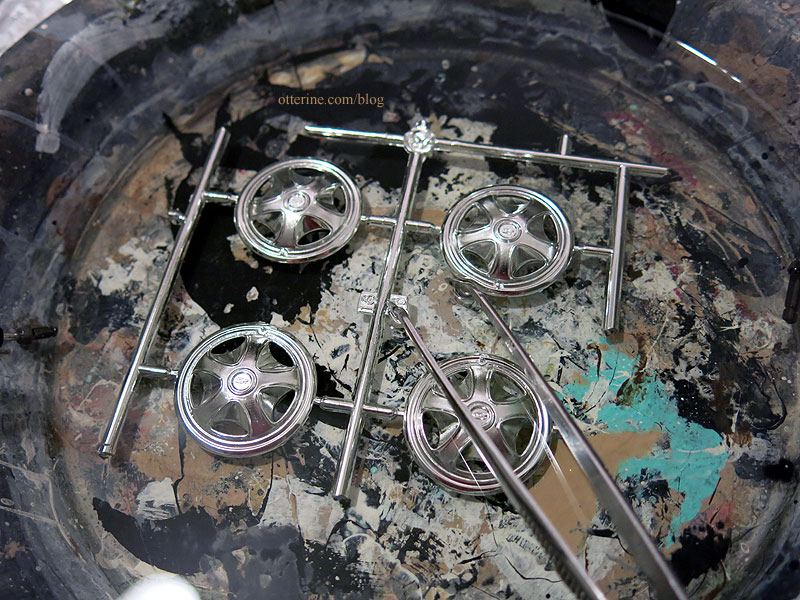
I don’t know if I will attempt painting these like the real deal, so this is a good compromise. Now they are less brilliant and yet still have good styling. It brought out the details actually, because it darkened the recessed lines by removing the finish in those areas. You can see the slightly yellow tinge next to the original parts. If the finish becomes unstable, it’s no worry to me…I can always paint them.
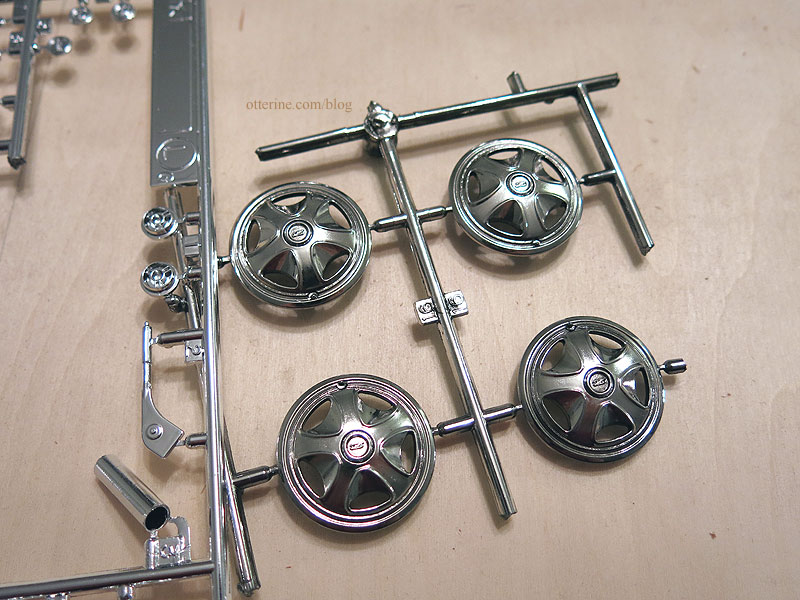
Removing chrome finish from plastic would definitely apply to the Chrysnbon bathroom kit. You could then paint the pipes and faucets any color you like. :] Or, you could do as I did and soak them a short time to weather them.
Categories: Milo Valley Farm, Model Cars, Vehicles
March 9, 2016 | 0 commentsMilo Valley Farm – old electrical pole
With the knob and tube system installed in the barn, it was time to figure out how to get power there. Enter the electrical pole.

I started with a 1/2″ wooden dowel cut to a proportional size of 16″ tall, not exact scale. I took into consideration the fact that the wires need to clear the barn door to reach the tubes on the side of the barn. I then brushed on a grey paint stain just in case any glue seeped out during the later steps. I marred the surface with sandpaper and an awl, then added more washes.
I cut the cross bar from basswood, painted and aged before assembly. The v-shaped stabilizer was cut from cardboard and painted to look like weathered metal. I used metal headpins and tiny brads for stability and nail detailing. I glued green adventurine cone beads onto the side wires and added aging washes.

These are as close to mini glass insulators as I could find. I picked up the real deal – a Hemingray-9 – at a local estate sale.

This needs to dry completely before I finish up the electrical work. :]
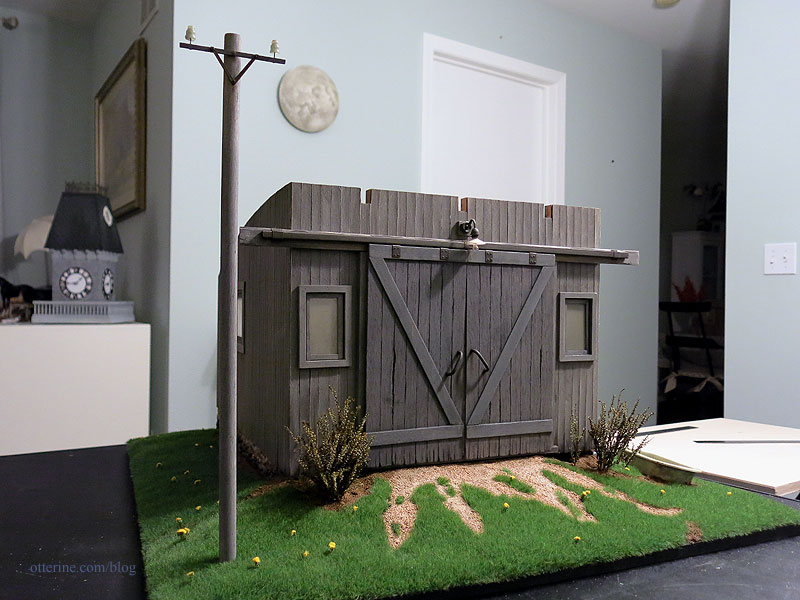
Categories: Milo Valley Farm
March 3, 2016 | 0 commentsMilo Valley Farm – landscaping, part 5
Continuing work on the landscaping. For a bit of non-grass vegetation, I have the Goldenrod Weeds “Silflorettes” by MiniNatur. These come all webbed together, and you cut the stalks off the web to apply individually. I have summer, late summer, and autumn colors. I will use the summer color here.
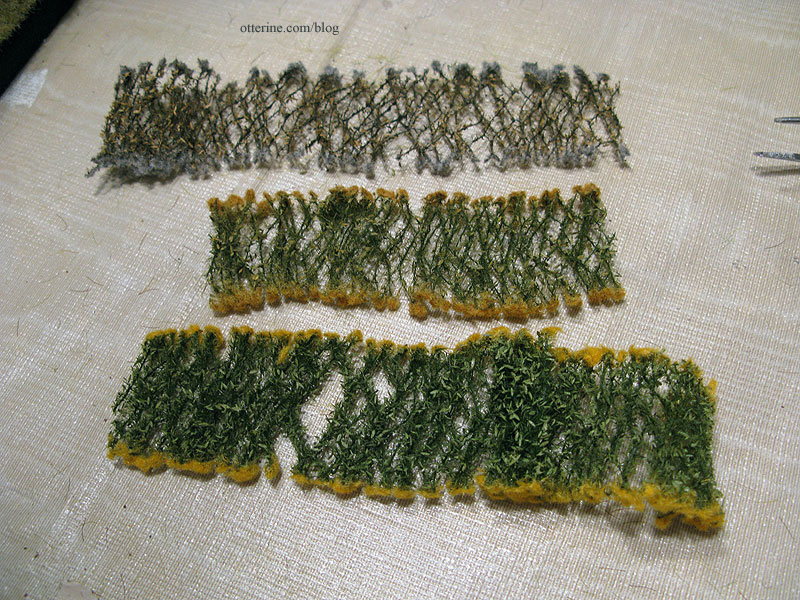
These are obviously not in-scale goldenrod stalks for 1:12 scale, but they do look like little flowering weeds. I used an awl to make holes in the ground to plant them. I left the awl in place while I prepped the individual flowers for planting, otherwise I’d lose track of the hole.

The landscaping here is spring/summer grass with a weed or two cropping up between mowing with the big riding mower.
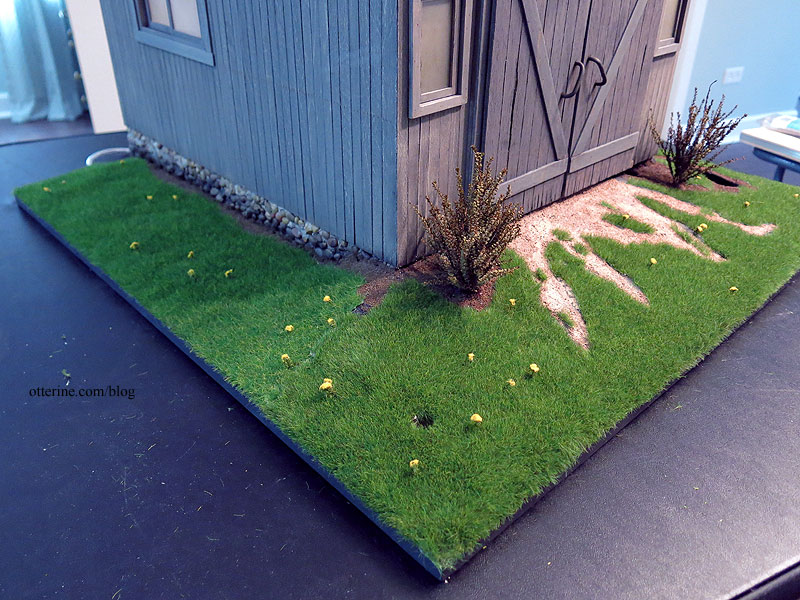
Time to plant the bathtub! I didn’t glue it into place; it’s just wedged into the foam.

Looks like our weedy bush is proliferating. :D

Here is the gravel ramp as it was after the initial grass was added.
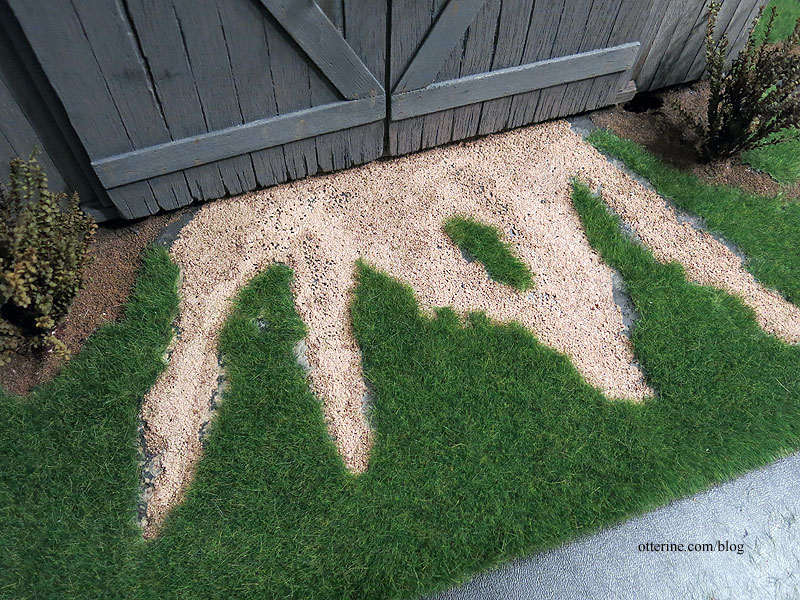
I added smaller bits of grass torn from the scraps to the gravel ramp to give it all a more realistic appearance.
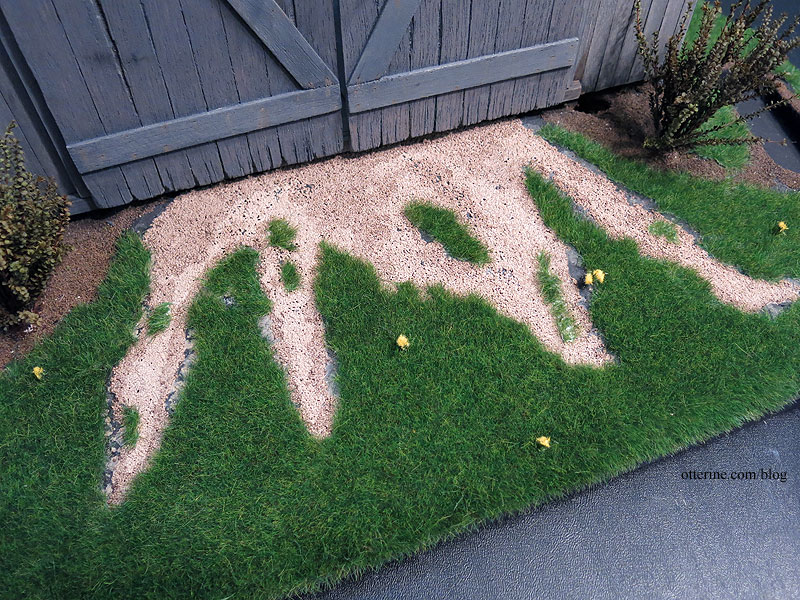
Previously, I had brushed glue onto the foam landscape, pressed gravel and ballast into place and removed the excess. This time, I carefully added the same material to fill in any uneven areas around the grass mat using a spoon.
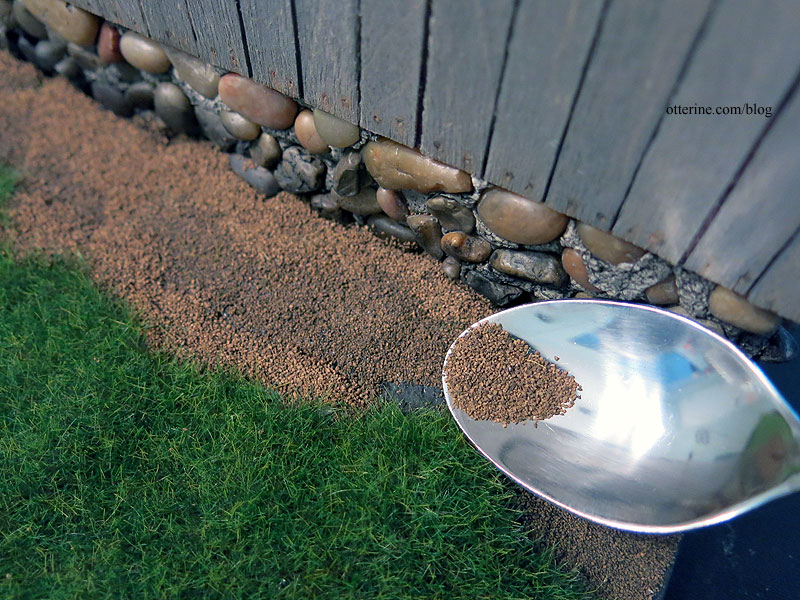
I didn’t worry about strays in the grass since that can be brushed away after the glue has set.
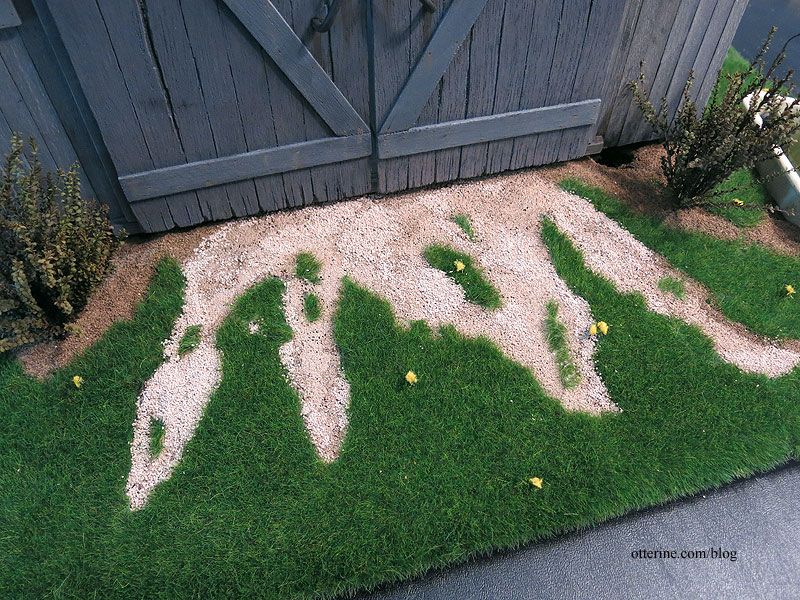
I used Scenic Cement to fix it all in place. Debora sent me some pipettes for application, and I had a cup of water on hand to rinse off the pipette in between sips from the bottle.

The Scenic Cement wanted to form droplets on top of the ballast materials, likely because they are smaller particles. I was able to break the surface tension and get the liquid to sink in by tapping the pipette along the surface. I didn’t want to use a sprayer since it wouldn’t be as easy to control.

I have learned that if you have something that sticks out and could be mistaken for sloppy work instead of a planned aesthetic, often the best solution is to draw more attention to it. Like this seam that didn’t go too well. If you have one of these, don’t overwork it. Just let it dry and address it after.
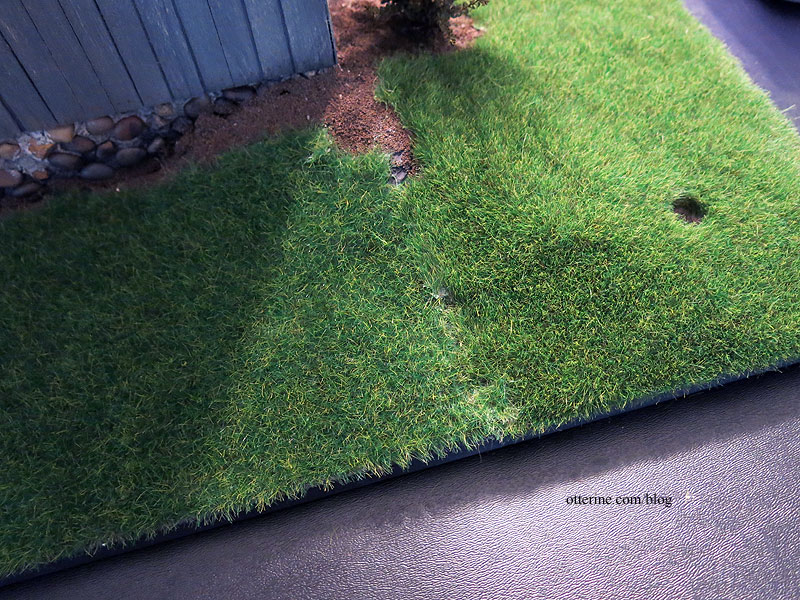
I added some dirt ballast and set it in place with Scenic Cement.
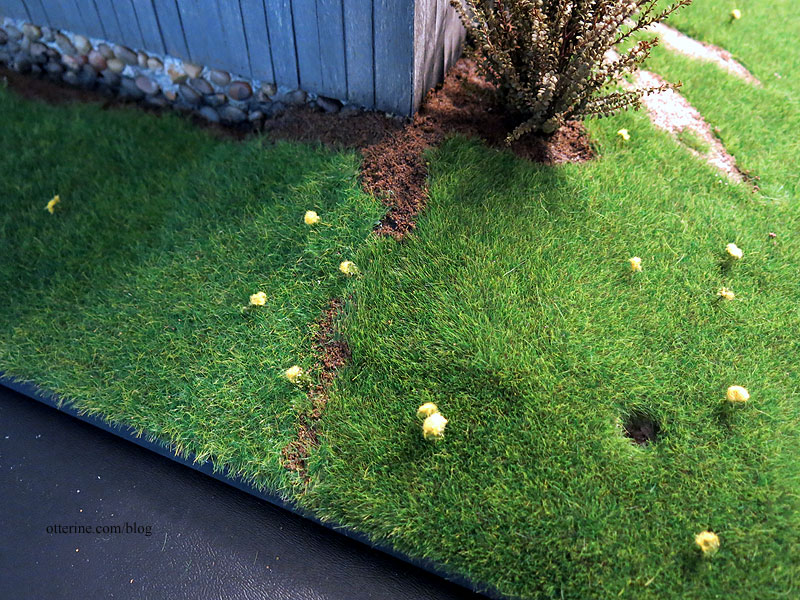
This seam on the other side is much more natural, so I left it as is. In fact, there are three seams here — only one can be readily seen but natural, one is faint and one is invisible. :]
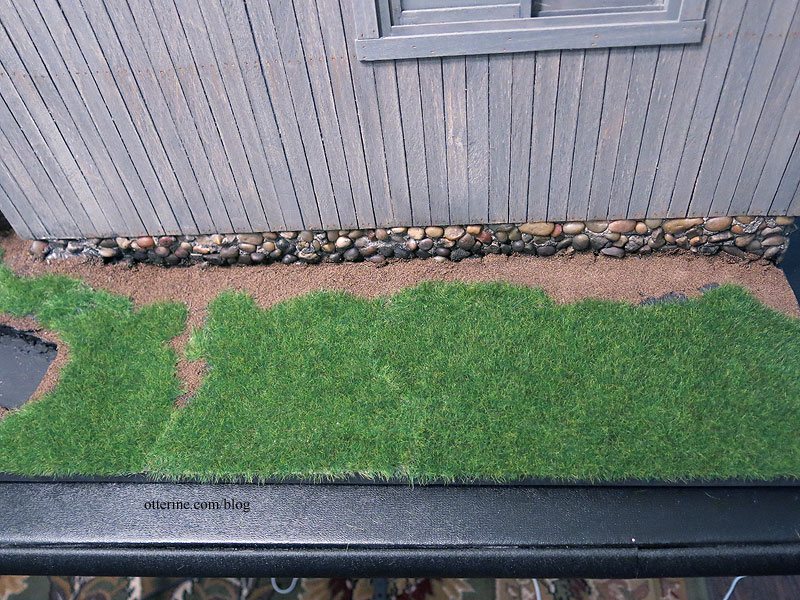
Once the glue set, I vacuumed the strays.

Friedrich is pleased with his burrow. :]

So, there we have it! No more floating barn. :D

Categories: Milo Valley Farm
February 21, 2016 | 0 commentsMilo Valley Farm – landscaping, part 4
Continuing work on the landscaping. The grass mat I will be using is Wild Grass in Dark Green by Heki from Scenic Express (they call it Summer Green TurfGrass on their website). It has high dark green grasses with some variegated coloration to simulate a wild but well-kept lawn. Just because there’s a barn find car inside doesn’t mean the whole property has to be an eyesore.
The grass mats are pricey, but the look is spot on in scale. The sheets are only 6″ wide, though they are 17″ long, so there are places on the landscaping board that will need to be pieced. I bought four to have enough, though I wasn’t sure I would need all of them.
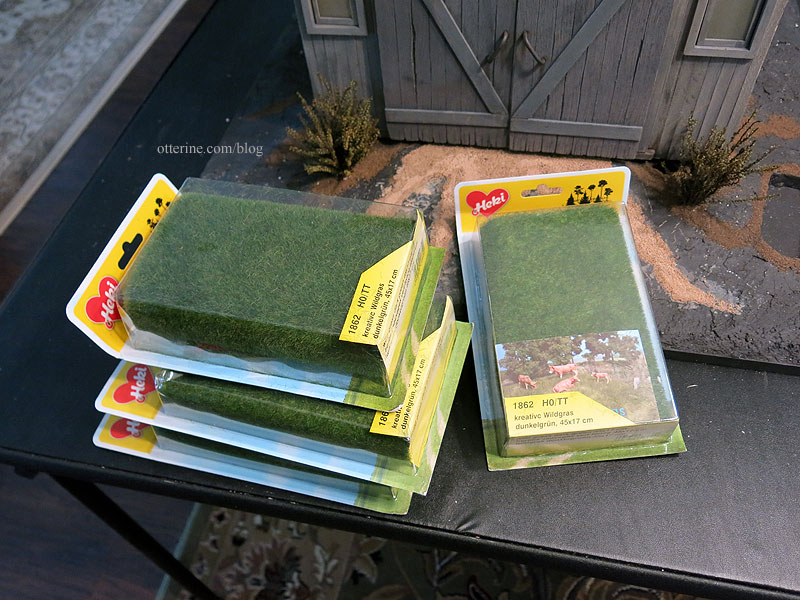
The backing of the grass is a clear, rubbery substance though not sticky. This makes it more flexible than the paper-backed grass mats, which will be good for the uneven landscape I need to cover. I peeled the grass sheet from the protective paper.
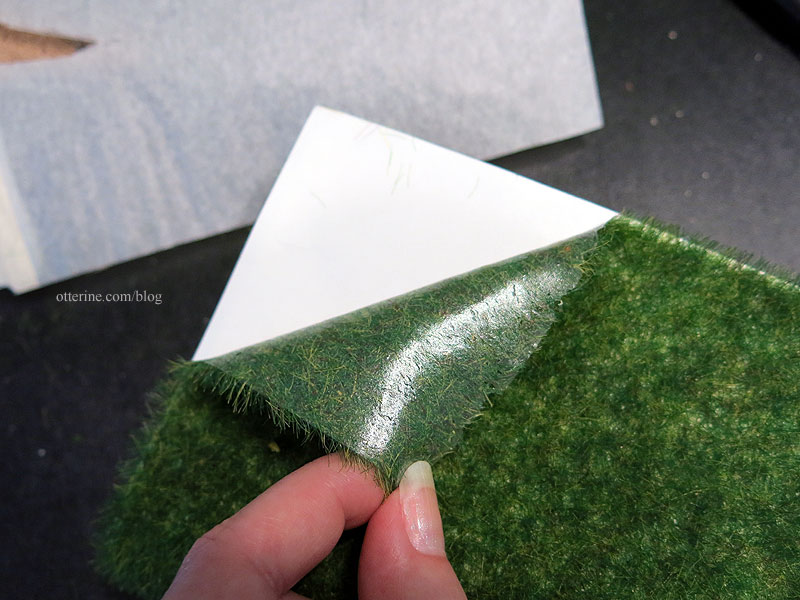
I pinned the paper template to the grass mat — there’s my sewing background coming into play. :D
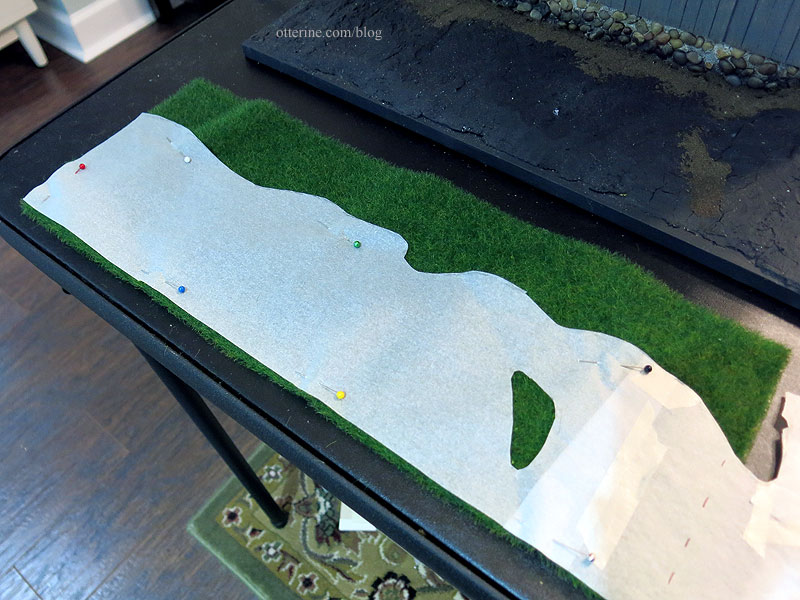
To make the divide between the grass and the dirt look less planned, I tore the grass mat backing along the edge. I checked the fit and made further adjustments. I decided to cover the bare dirt patch I originally had planned.
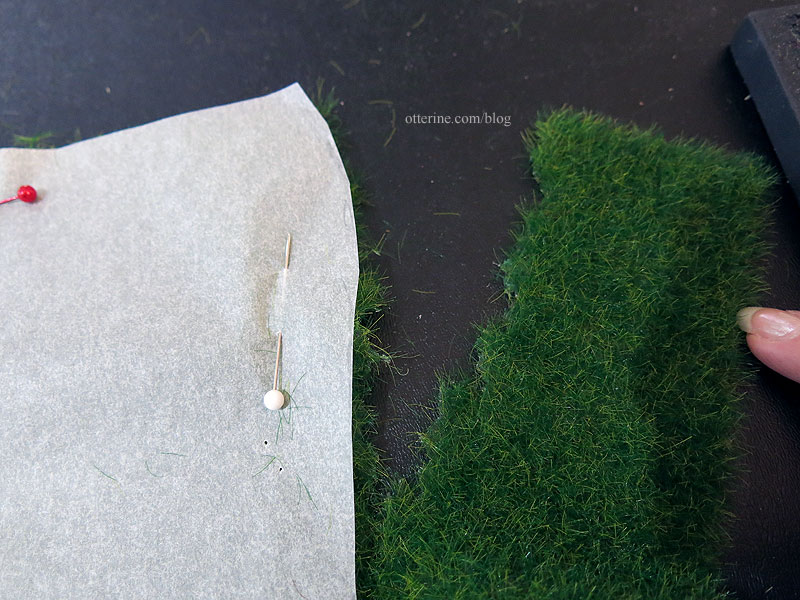
I spread Weldbond glue on the base board and on the edges of the grass mat.
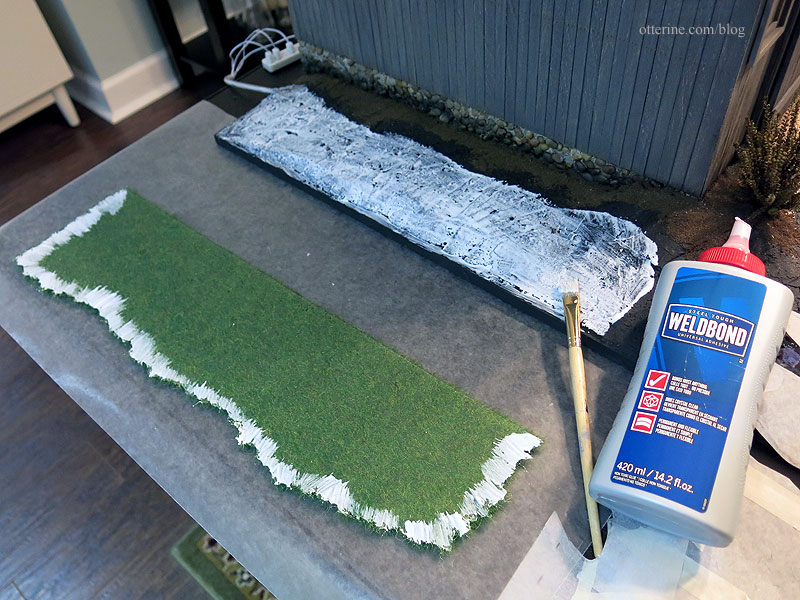
I pressed the grass into place, using a scrap of strip wood to fine tune the edges so I could press the grass into place without flattening it.
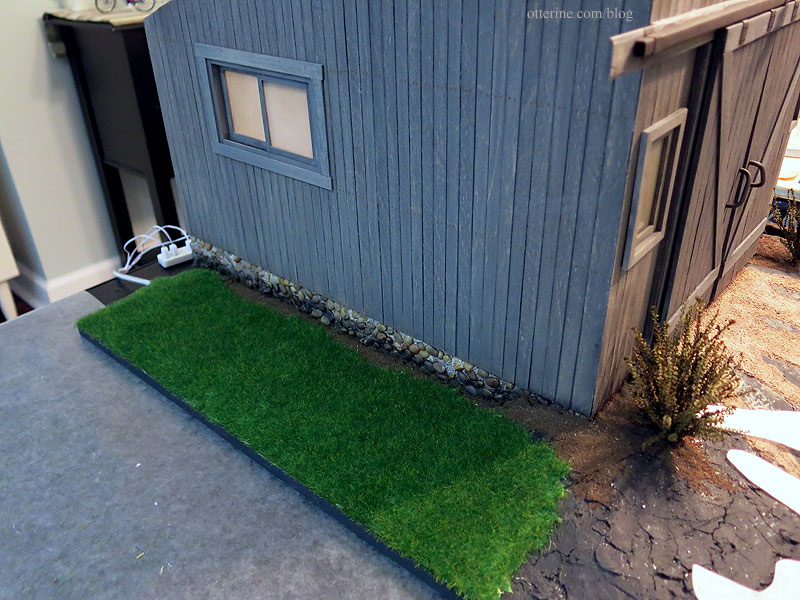
Any bare spots are easily pieced from the saved excess.
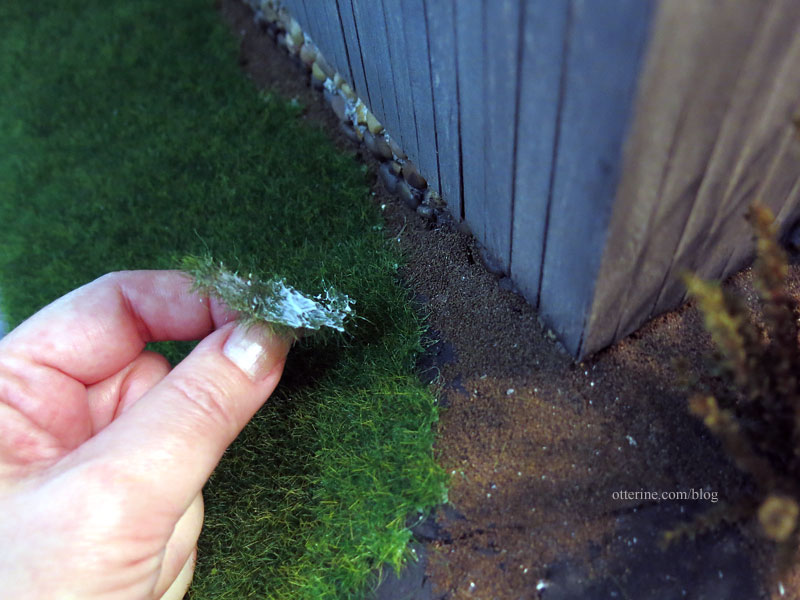
The material backing is what makes this type of seamless piecing possible. I’m not worried about any of the backing showing at the edges right now. All of this will be addressed in the final detailing.
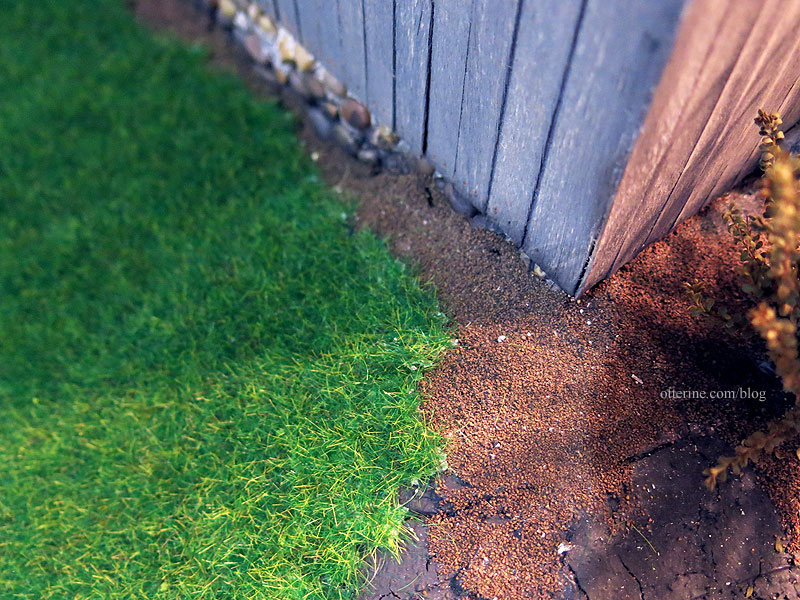
I continued the process until the entire surface was covered. And, yes, this is a messy process. :D
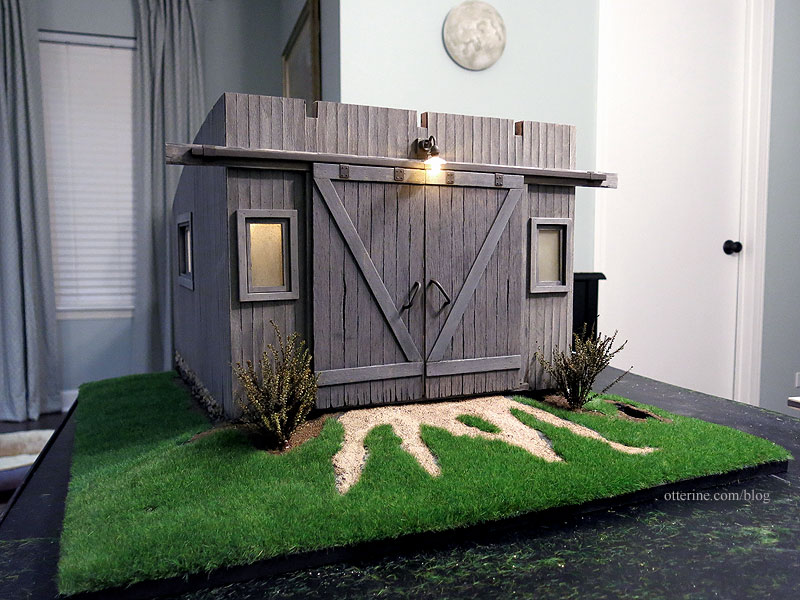
Categories: Milo Valley Farm
February 15, 2016 | 0 commentsMilo Valley Farm – overhead light
I’m using a Meyers Wall Light for the front of the barn. I used pliers to bend it outward a bit, which removed some of the paint. That’s fine for an old light, and I brushed on flat black paint to remove the gloss shine. Once that was dry, I dry brushed on dark brown to make the finish appear corroded and dirty.

Since the door frame sticks out, I added a square of scrap wood to serve as a base for the light.
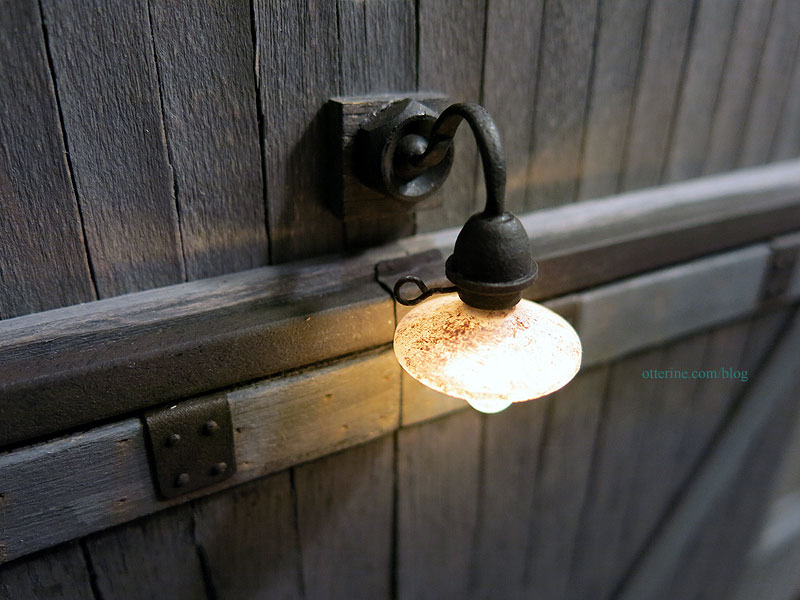
On the inside, I connected the lamp wire to the 12V wire I fed during the overhead light installation.

before – showing the wire I covered the wires with channel molding. I didn’t bother adding knob and tube wiring for this lamp since it would have been hard to see and just make a mess of the work I did previously. :]
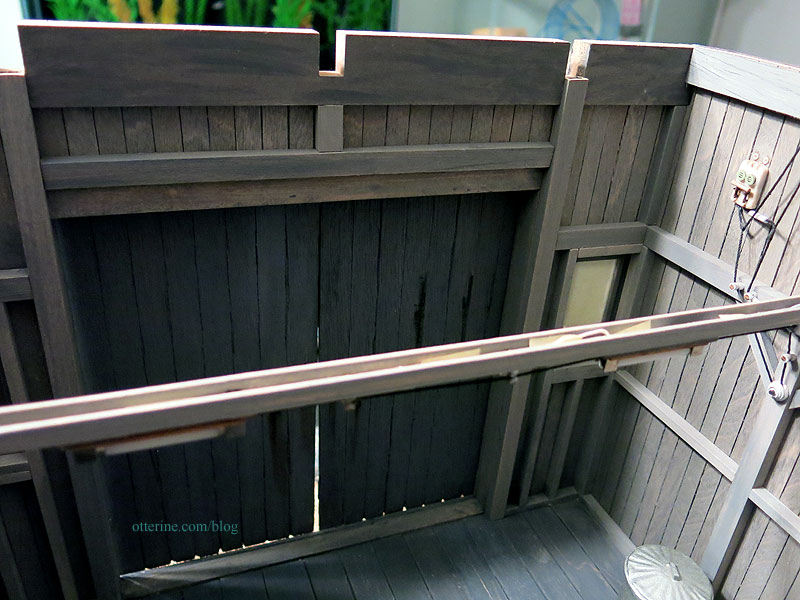
Just a few modifications and it looks like an old barn light that’s been there a long time.
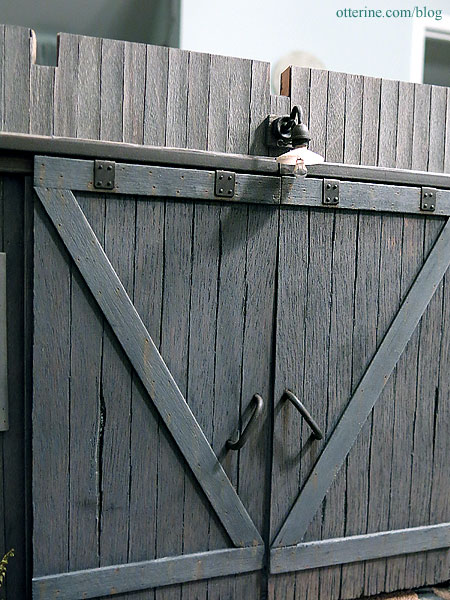
Categories: Milo Valley Farm
February 14, 2016 | 0 commentsMilo Valley Farm – barn doors, part 4
Finishing up the barn doors. Glue will be the main support for the tubes. I used The Ultimate by Crafter’s Pick supplemented with dots of super glue gel, leaving a slight gap in the middle. I’ll explain why in a moment.
I added strips of wood around the rest of the door opening to help with the slight gap between the door frame and the doors. This won’t block all of the gap, but it will help. This might not have been necessary had I planned better, but let’s just say this is a replacement set of doors tacked onto the front after a wayward tractor mishap. haaaaaaaaaaa!

I added brackets to either end. These are black craft paper not zinc since they are mainly for show not function. Plus, it was easier to make them from paper and get a good fit.

I faked the tiny nails with paint.
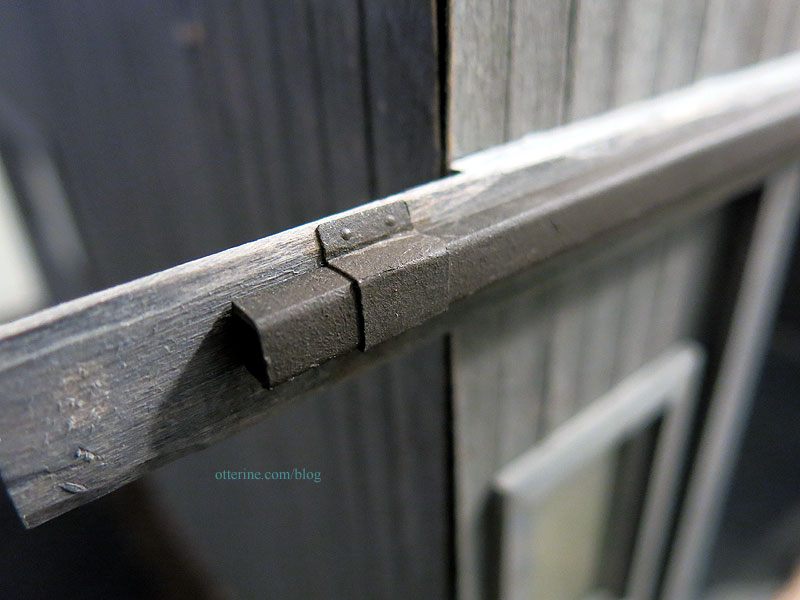
Moment of truth! I slipped in one door and then the other. The gap allows the pin head (hahaha – it never gets old) to fit in between.
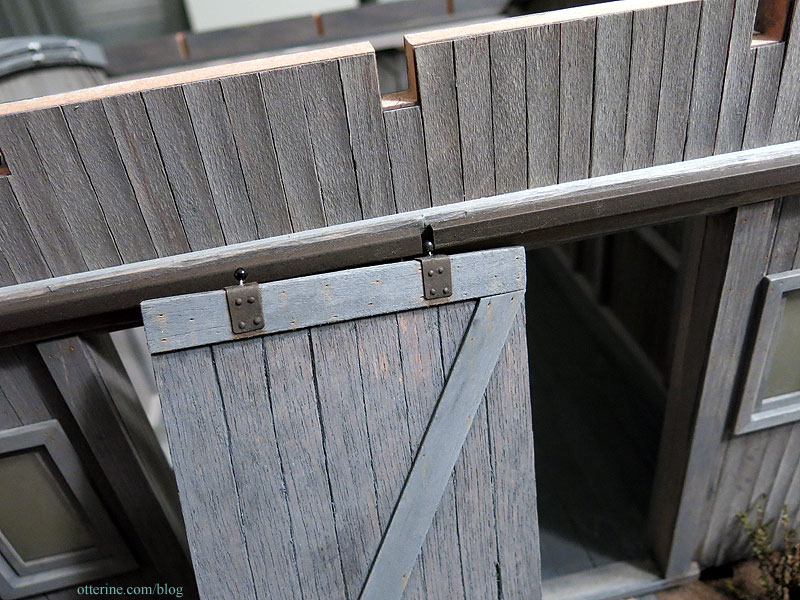
The door slides in the track until the other pin head can slip into place. It took a few tries to fit the doors well. I bent the pins until they hung properly in the track. They can’t be moved using only the handles; I have to grip them by the sides to slide, but that’s just fine with me. :]
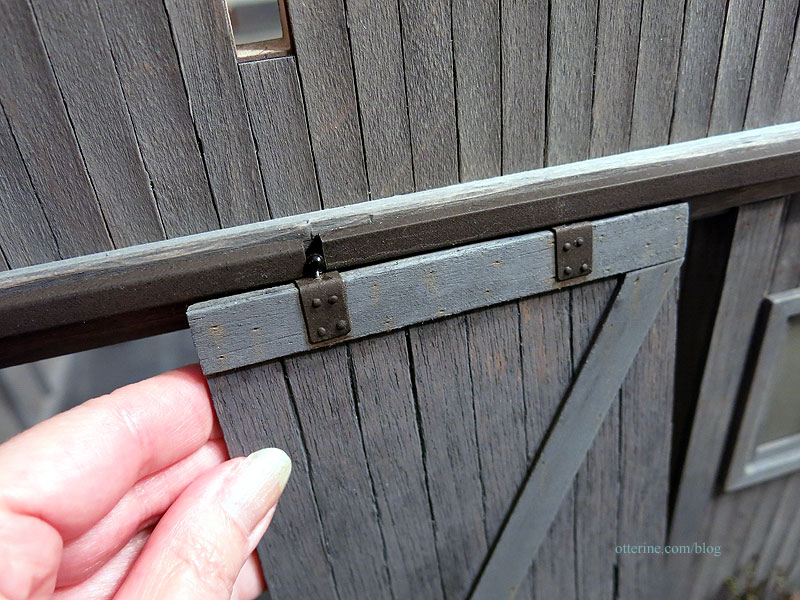
I added the final bracket in the middle to cover the gap. If I ever have to work on the doors, I can peel the paper bracket loose.

Hooray! :D

Perhaps there should be a handle inside, but…I kinda love it as is. One of my art professors once said it takes two people to make a work of art; one to do the work and one to hit that person over the head when it’s done. :D I going to hit myself on the head concerning the doors. We’ll just say there’s enough of a gap to get a hand in there to pry them open.

Categories: Milo Valley Farm
February 11, 2016 | 0 commentsMilo Valley Farm – barn doors, part 3
Continuing work on the barn doors. I brushed Testors black inside the plastic tubes as best I could. I let it dribble through from each end and soaked up the excess with a paper towel. It didn’t need to be perfect, just to hide most of the white plastic.
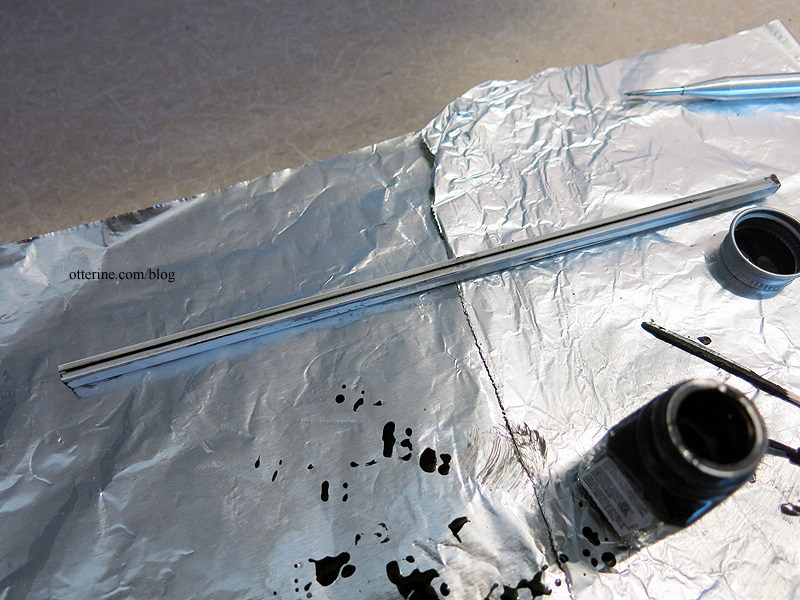
I then spray painted the plastic tubes and bracket hardware flat black. I stippled on dark brown to simulate aged and corroded metal. It’s a subtle finish.
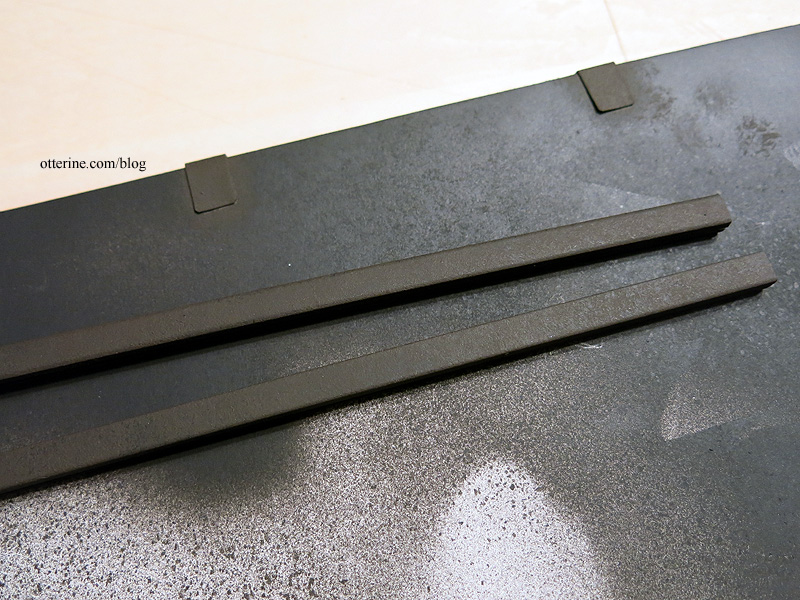
I made door handles from brass tubing and sprayed those and the sewing pins with Rust-Oleum Self Etching Primer to help the paint stick better. I taped the pin heads (hahaha I said pinheads) to keep them free of paint. I then sprayed them flat black and added the stippled brown paint. The etching primer did not matter on the pins — the metal is too smooth. So, they will require touch-ups for life. =shrug=
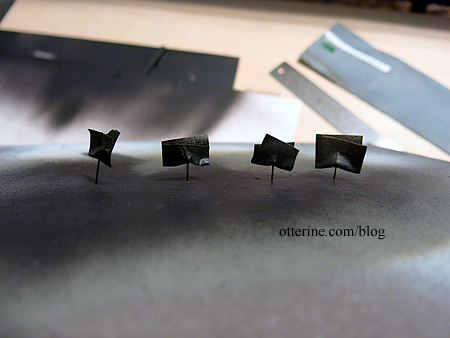
I drilled holes through the door and glued in black brads to finish the end holes. I added aging washes to the surrounding wood and painted the brads to look like corroded metal. I installed the handles at an angle, because I liked the look of it. :] Here you can see the back of one door and the front of the other.
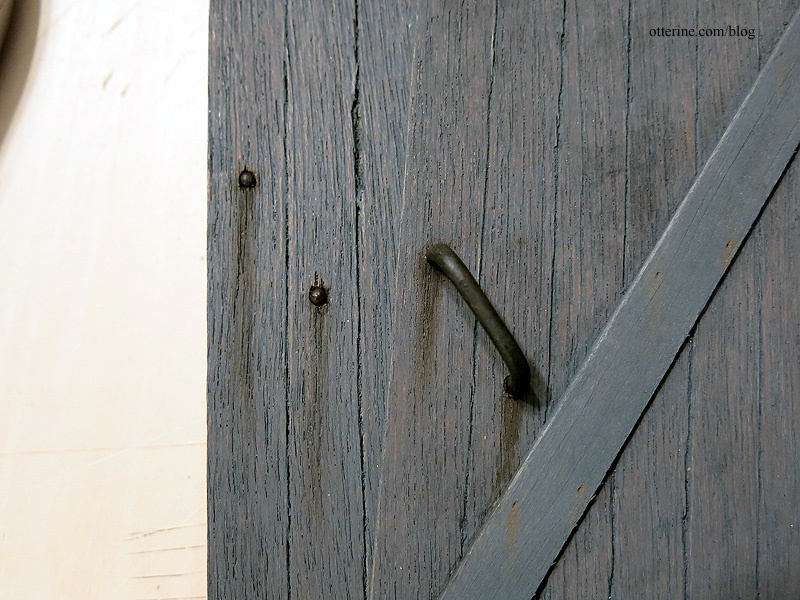
I drilled pilot holes in the brackets for tiny nails. I glued the brackets in place and supplemented the hold with the tiny nails. The fronts have four nails and the backs have two so they wouldn’t interfere with each other.
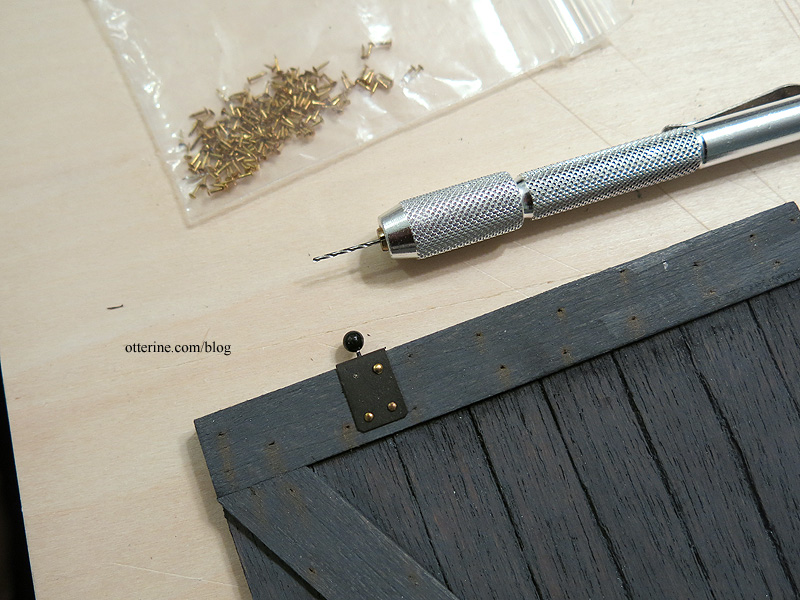
I used The Ultimate by Crafter’s Pick (thanks to Keli for recommending this glue for attaching metal to wood) for the brackets and dipped the nails in super glue gel.
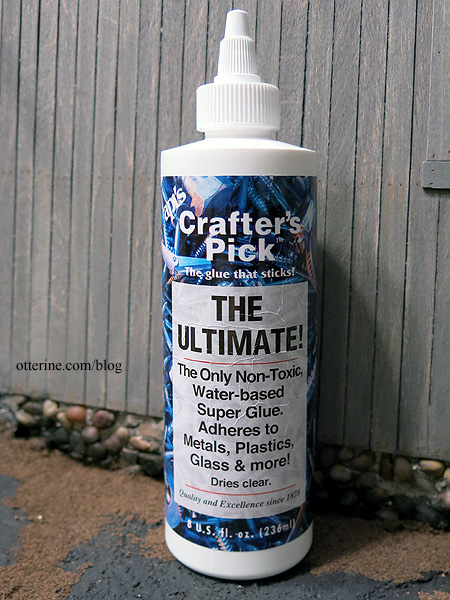
The nail heads varied in size in the packet (noticed after they were glued in place, of course) but once painted to match they weren’t noticeable.
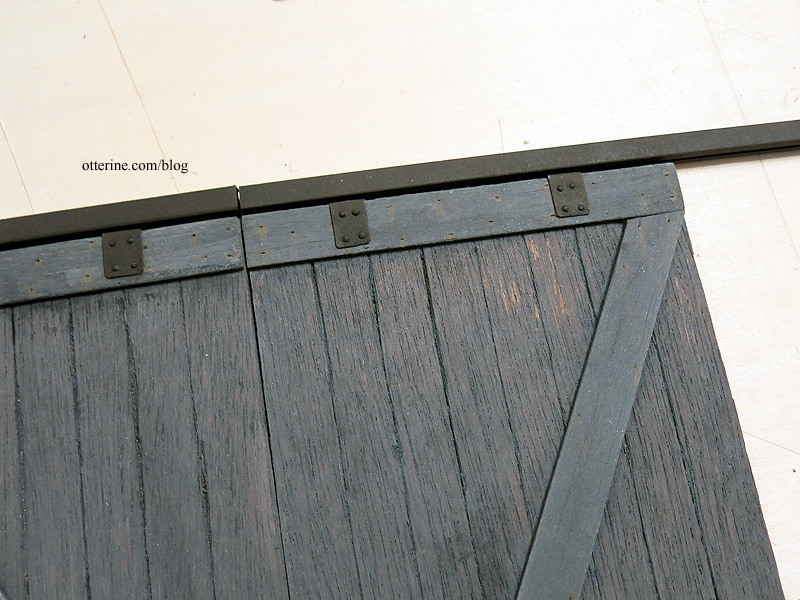
I will let all of this dry before installing the doors.
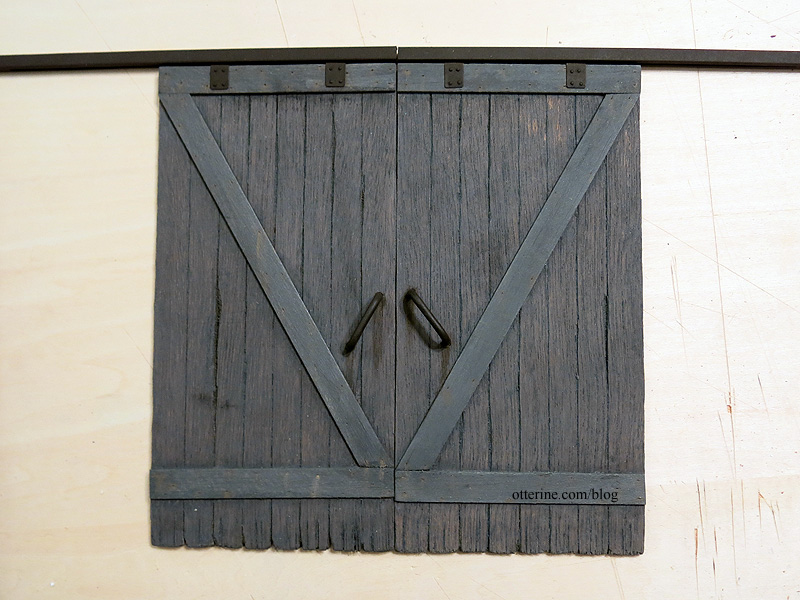
Categories: Milo Valley Farm
February 9, 2016 | 0 commentsMilo Valley Farm – barn doors, part 2
Continuing work on the barn doors. I cut new upper reinforcements from basswood since I didn’t like the texture of the plywood edges. I marred the basswood pieces to make them look like old wood.
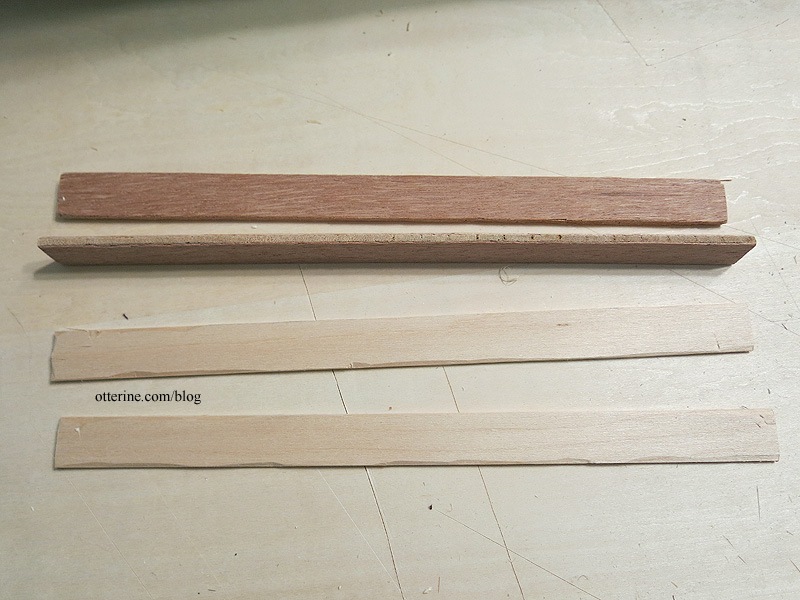
I added all the nail detailing I needed to finish the overall look and then installed the pieces.
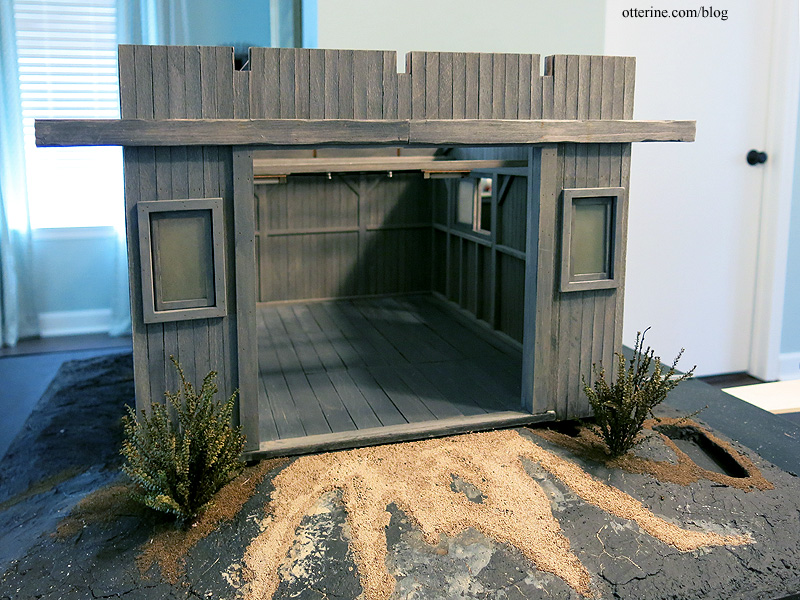
As noted previously, I will be making a rail that will extend past the end of the building on either side. I saw this setup in real life at a wedding locale — Proven Ground Farm. The real life version has a round metal pipe that houses the top part of the hardware attached to the barn. My best guess is there are rollers inside the pipe.
I’m using rectangular plastic tubing to have a larger surface to attach to the barn itself. The first order of business was to cut a track opening. I sandwiched the tube between two boards and taped everything together. I clamped the boards to my cutting table.
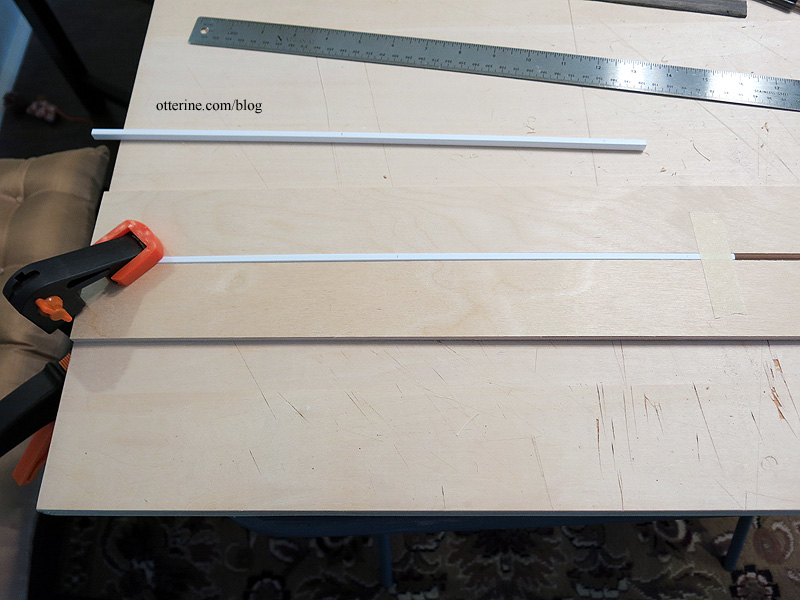
Using a sharp X-Acto blade and a metal ruler, I made a tiny channel in the tube.
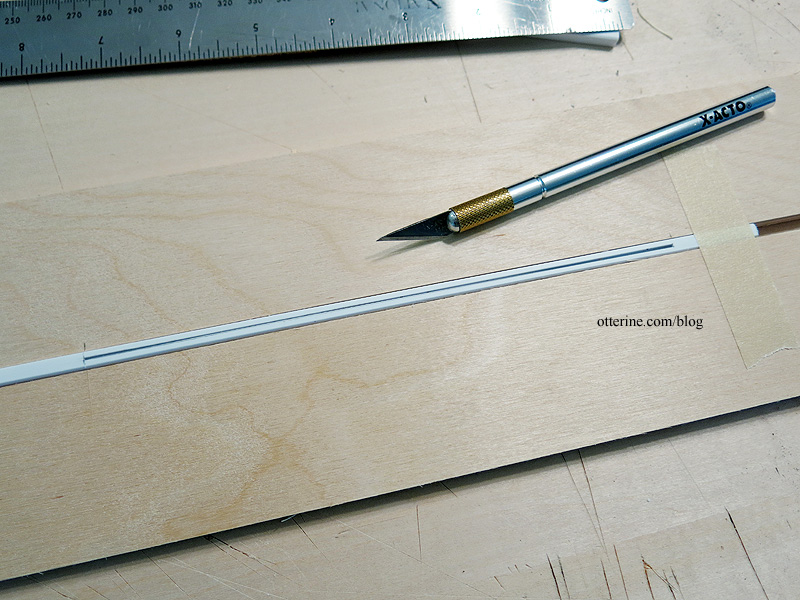
I left the tube long so I would have enough leverage to hold onto it. After the channels were in place, I cut the tubes to fit. Each tube has a channel that is closed on one end and open on the other.
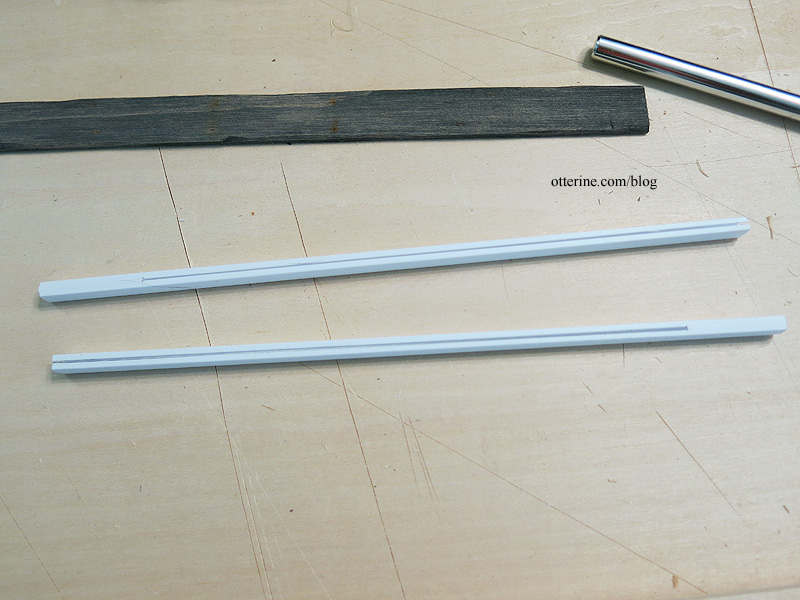
Bill sent me some zinc metal sheet awhile back. He likes working with it to make interesting minis. I haven’t worked with metal a lot, but this is a fine time to start! I cut four strips 5/16″ wide by 2″ long. I wanted some extra length since I was making things up on the fly.
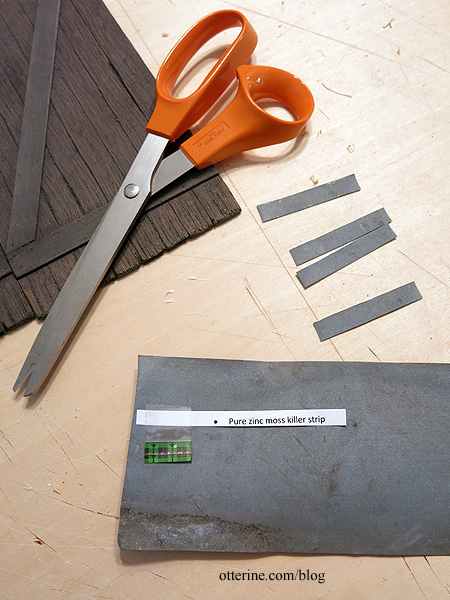
I bent the zinc over the tops of the barn doors, two per door. I marked and cut the excess, using nail clippers to smooth the corners.
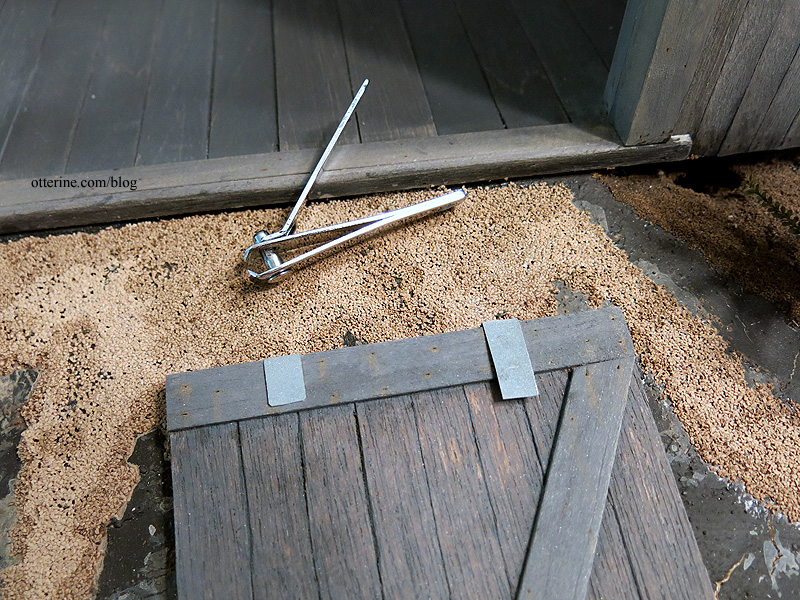
I marked the brackets for tiny brads on each side. The nails are on order and I have to paint the hardware anyway, so the slight delay won’t be for too long. I drilled a hole in each top center. This will hold a ball-top sewing pin, cut to fit.
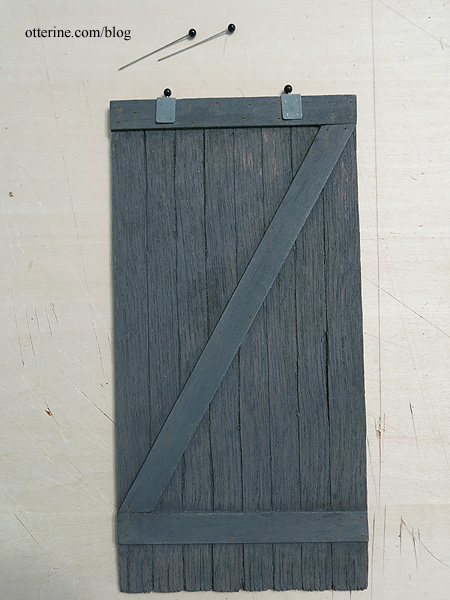
These will serve as the rollers inside the tubing.
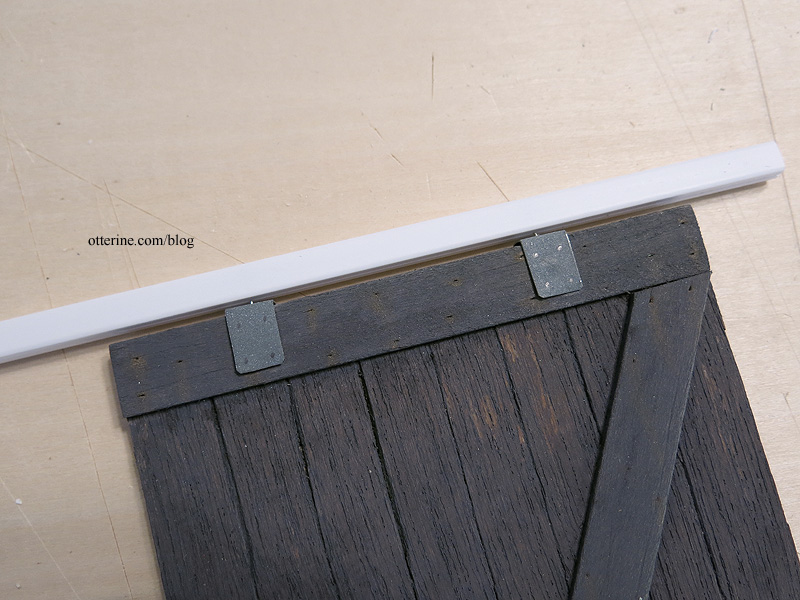
Next up, painting the plastic, hardware and installing the doors.
Categories: Milo Valley Farm
February 6, 2016 | 0 commentsMilo Valley Farm – knob and tube wiring, part 4
With the 12V lights wired, I continued the knob and tube system along the side wall. This was my initial map (I changed the cleats to knobs in the last post).
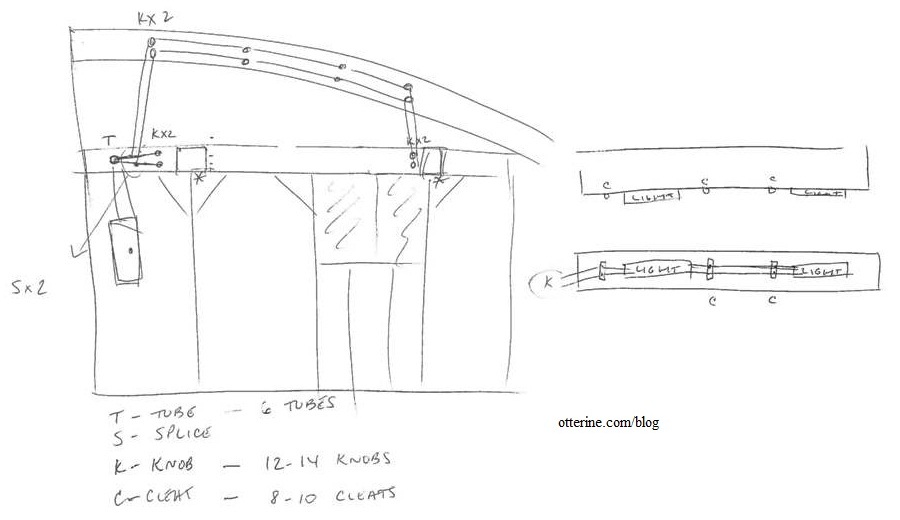
I started with the lower cord from the back cross beam. The process is the same as it was for the cross beam knobs: headpin through the upper knob portion, through the cord, into the lower knob portion and glued to the wall.
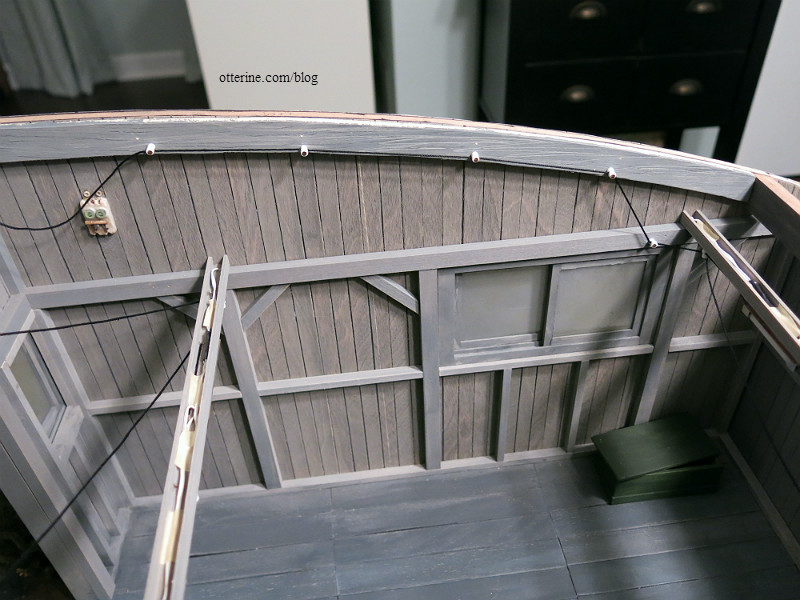
Once that track was in place, I addressed the upper cord from the back cross beam. After reaching the front of the barn, I had to splice the cord wires together. I used masking tape then painted it black.
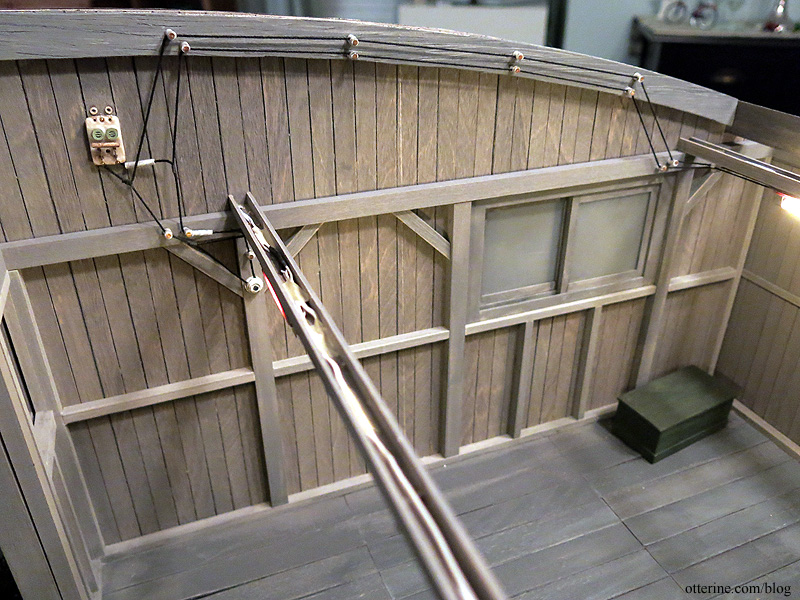
Those four splices required an unusually high amount of curse words to fall into place. Anytime the two cords touched, I slipped a cut of plastic tube onto the cord. One splice is damn close to a knob nail — likely a scary feature of many a real barn. :O

As I mentioned before, much of this exposed work would have been done with cleats instead of knobs, but I like the look of the knobs and perhaps the builder just used whatever he had the most of in the old barn. Here’s an excellent video on knob and tube from Edison Tech Center.
I led the wires down the wall to a key switch (made from a bell push from Sussex Crafts and a wood disc). I will add the “safety feature” rope to yank in case of disaster closer to the end since it will just be in the way when I attach the exterior electrical wires to the fuse block.

It may seem low, but it’s only because there’s nothing to show the spatial relation of the barn. :]

To age all of this madness, I scraped some chalk pastel dust into a bowl and then dusted it onto the cord. It toned down the true black of the cord material. I used some grey and brown paint mixed with Americana Staining Medium to dirty the knobs and tubes.

This whole setup is damn scary, so it’s a good thing it’s just for show.


A lot of this was guesswork since much of the knob and tube wiring examples I found are modern inspection photos of improper splicing with modern wiring. But, I think I managed to capture the essence of it, no? :D

image from Wikipedia Only a few things are left for the actual barn structure — barn doors, exterior electrical work, landscaping and roof. I think I’ll leave the roof off until I am done with the car, which will have to wait for spray painting weather. So, I’ll work on the barn doors next.
Categories: Milo Valley Farm
February 3, 2016 | 0 comments
NOTE: All content on otterine.com is copyrighted and may not be reproduced in part or in whole. It takes a lot of time and effort to write and photograph for my blog. Please ask permission before reproducing any of my content. (More on copyright)

Milo Valley Farm – a barn find build
This post has the “best of” photos along the way to completion. This post will change as the build progresses.
——
Milo Valley Farm is built from Denise’s City Cottage, which was the miniatures.com Creatin’ Contest kit for 2015, but I didn’t enter this build since the kit was a free gift from them as part of their blogger outreach campaign. Here’s Denise’s City Cottage as it looks built to spec.

kit photo from miniatures.com The idea behind the build is making a barn find diorama. Here are two great examples of the look I’m going for: a 1961 Jaguar E-type and a 1952 Barn Find Cunningham C-3 Coupe #5209. Barn finds can be quite sad looking at first sight but turn into cash cows and museum gems. I love this Charger, too, though so I am sure I will fluctuate between a before and after barn find car. :]
I named this build Milo Valley Farm after a dear hamster friend, Milo.

I’ve made the structure narrower but added to the depth.

I made these changes to accommodate the 1:12 scale Tamiya Datsun 240ZG.

The car is a work in progress beyond the end goal of making it a barn find.

It’s an incredibly detailed model.

I added a taller foundation and used builders foam for the main landscaping base.

The foundation is covered with aquarium pebbles and stucco patch.

The siding was applied using templates. I added nail hole detailing and aged the wood.

There’s a removable wall to enclose the back. The handle is disguised as an old bar used to tie up horses.

I made a black paper template of the floor. This is the same material used for the siding but left full width. I used the same painting technique as I had for the siding for the base color. I applied a few dark washes to age the planks, even dropping some puddles in places to make stains. These were lifted and reapplied a few times over. I added wheel marks and residue rings from cans that have leaked. I will add more later on during final finishing.

The windows come already assembled, so they required some disassembly for finishing. I used the same painting technique as I had for the siding to finish the frames. I then aged the clean acrylic inserts to cloud the glass, reduce the shine and add some color depth to the dust. You can always add more, but too much paint will look like…well…painted glass. :D These windows will be seen from the inside and outside, so I went with a lighter color to simulate dust.

With the windows and flooring installed, I could address the interior structure. This is by no means meant to be a precise carpentry replica. It’s meant to disguise seams and give the illusion of a structured barn as well as provide a way to hide the 12V wiring system.

The barn has a faux knob and tube system made from plastic tubing, plastic rod, crochet thread and copper headpins. I mapped out the course of the knob and tube with sewing thread to work out any issues before installing the real deal. Below is the real deal.

image from Wikipedia Much of this exposed work would have been done with cleats instead of knobs, but I like the look of the knobs and perhaps the builder just used whatever he had the most of in the old barn.

I led the wires down the wall to a key switch (made from a bell push from Sussex Crafts and a wood disc). A lot of this was guesswork since much of the knob and tube wiring examples I found are modern inspection photos of improper splicing with modern wiring. But, I think I managed to capture the essence of it, no?

I made the porcelain fuse block for the service entrance from polymer clay (Sculpey in Pearl) since it was easiest to mold and shape and would look enough like porcelain to pass. I used jewelry findings for the connectors. The fuses are made from brass and silver watch parts (painted) and two clear plastic discs. The switch doesn’t pivot; it’s glued in place.

The actual 12V electrical system is hidden in the channel molding that forms the beams and posts.

The old barn light was made from a Meyers Wall Light. I brushed on flat black paint to remove the gloss shine. Once that was dry, I dry brushed on dark brown to make the finish appear corroded and dirty. Since the door frame sticks out, I added a square of scrap wood to serve as a base for the light. Just a few modifications, and it looks like an old barn light that’s been there a long time.

There’s a receptacle inside an old sea chest. The wiring leads out through the foundation and is covered by the landscaping foam (that process here).

The 12V lighting features some new old stock E-Z-Lectric light fixtures from ItsyBitsy Old Stuff. These are great since they already look a bit aged; a few of the bulbs show crackling in the frosted glass finish.

They provide the perfect amount of old, yellow light for the barn.

The old electrical pole was made from a 1/2″ wooden dowel cut to a proportional size of 16″ tall, not exact scale. I took into consideration the fact that the wires need to clear the barn door to reach the tubes on the side of the barn.

I cut the cross bar from basswood, painted and aged before assembly. The v-shaped stabilizer was cut from cardboard and painted to look like weathered metal. I used metal headpins and tiny brads for stability and nail detailing. I glued green adventurine cone beads onto the side wires and added aging washes. These are as close to mini glass insulators as I could find.

I cut the roof board down since I had narrowed the building. I had to cut an additional piece for the back since I had made the building deeper. Interestingly enough, I ended up with an extra roof board since the one that came with the kit originally was damaged so I had enough to cut the extra piece for the back from the same material.

I made a template for the ceiling from black paper and used the same thin wood strips as I did for the siding to mimic a plank ceiling. I made sure seams hit where a beam would cover the gap, and I alternated the placement so it wouldn’t tend to bend along that break. I left a tiny bit of room between the boards to allow for the curve. I painted it to match the rest of the interior siding. Here it is propped in place to test the fit.

The barn doors were scratch built. I made a rail for sliding doors that extends past the end of the building on either side. I saw this setup in real life at a wedding locale.

The doors can’t be moved using only the handles. I have to grip them by the sides to slide, but that’s just fine with me. I love how they turned out considering I made it up as I went along.

Perhaps there should be a handle inside, but…I kinda love it as is. We’ll just say there’s enough of a gap to get a hand in there to pry them open.

Interior Accessories
While building, I’ve taken some time to make some minis for the old barn like these 1:12 scale license plates. :D

These are made from paper but look like old worn metal and even have the embossed detailing of the real deal.

Bill sent me a whole bunch of marvelous mini tools that he made.

I’ve made a few items from a 1/12 scale Tamiya tool set. The vintage Texaco jugs I found online were all red, but I liked the white on the kit box, so I stuck with that.

For the polyethylene tank, I added the same grime and painted the cap red. One of my favorite details is the dribble of dried liquid down the side.

I can’t take credit for the sign other than the discovery at Hobby Lobby. It’s a magnet and the surface has embossed detailing. They had several kinds of old time logos and signs, but I stuck with the Texaco brand from my other accessories. No reason for the preference. It’s been an unplanned theme.

These fabulous miniature cinder blocks were sent to me as a free sample from Mini Materials.

Landscaping DetailsThe landscaping is meant to be rural but not unkempt. I planted two greenery bushes purchased from A Little More in Miniatures at the mini shows earlier this year. They smell awesome. There is, of course, a rabbit hole. The rabbit is Friedrich, and he will live on Milo Valley Farm. He is incredibly realistic and full of personality.

For the non-grass detailing, I added Fine Ballast Dark Brown by Woodland Scenics around the edges of the barn and used a lighter colored Woodland Scenics Ballast left over from Baslow Ranch for the disappearing ramp. The grass mat is Wild Grass in Dark Green by Heki from Scenic Express (they call it Summer Green TurfGrass on their website). It has high dark green grasses with some variegated coloration to simulate a wild but well-kept lawn. Just because there’s a barn find car inside doesn’t mean the whole property has to be an eyesore. :D

I added Goldenrod Weeds “Silflorettes” by MiniNatur. The landscaping here is spring/summer grass with a weed or two cropping up between mowing with the big riding mower.

I made a delightfully disgusting abandoned bathtub to plant in the landscaping. This is a Chrysnbon plastic tub painted and aged. Herbert the frog is by Amanda Skinner.

I love that the tub looks like heavy cast iron that’s seen better days. :D

Looks like our weedy bush is proliferating. :D

more to come…
Categories: Milo Valley Farm
April 10, 2016 | 0 commentsDatsun 240ZG – part 5 – initial aging
Continuing work on the Datsun 240ZG. The engine compartment of my barn find auto shouldn’t be showroom new, but of course the Testors Fiery Orange turned out showroom new. :\ Ah, well…easily fixed.

I sprayed the compartment with Testors Frosted Glass. I am sure you can use any matte finish spray, but I had this one on hand. It tones down the shine and gives the subsequent paint treatments something to grab.

Next up, adding grime. The easiest way for me to add grime is with acrylic paint and Americana Staining Medium. I mixed blobs of browns, greys and black with the staining medium and used a variety of soft brushes.

I didn’t worry about areas where parts will be glued in place since it’s part of the process to scrape those places clean before gluing anyway. The transparent stain mixtures created realistic dark areas without completely obscuring the orange body color. The staining medium adds a bit of sheen, which works well for engine grease. :]

Flip it over to age the underside, turning the pristine flat black into road-worn dirt. :D Here I brushed on undiluted paint using a stencil brush, repeating the process for several layers.

This removed the smooth finish of the plastic base.

Using the leftover staining mixtures, I added a bit of light aging to the engine assembly. More can be added later, but it works in my favor to add some now while tight areas are easily accessible.

I’m not overdoing the process. I prefer subtle aging that adds depth and visual weight. :]

I started sanding and detailing the main body piece. This is an excellent model, so there was very little to do in the way of prep work, just light sanding here and there. I had spray painted the body with a quick pass of grey. This paint layer helps highlight the imperfections and excess plastic from the molding process. Cinder blocks from Mini Materials.

There’s a vent detail in front of the windshield. It didn’t take the initial coating of primer spray very well, so I decided to detail it now. Any subsequent spray-painting shouldn’t interfere with the work. I used a toothpick to drop in Testors flat black.

I wiped the excess with a paper towel.

This fills the vent and makes it look like an opening in the body. I can touch up the effect after the final body color by using acrylic paint, which won’t stain the enamel color the way the Testors paint would. This is a good base to build on later.

Back in the engine compartment, I wanted the washer fluid tank to look like it contains actual fluid so I spent several hours painting it. The tank isn’t glued in yet, but the holding bracket is. I needed to know the angle of the tank to paint the fluid line at the appropriate slant. Dirtying up the surface helps sell the idea. :]

Categories: Milo Valley Farm, Model Cars, Vehicles
April 3, 2016 | 0 commentsDatsun 240ZG – part 4 – engine work
I knocked out two pages of instructions for the Datsun 240ZG this weekend! This isn’t all of the work I completed from those pages, but this is the main piece in progress.

I’ve looked at some real life engine photos for color but I’ve mostly followed the instructions. Fine detailing, aging and grime will come later.

It’s coming together nicely. I added some painted detailing in the way of bronze nuts and bolts. Making nuts and bolts a different color can add realism with a minimal amount of work. I also used electrical tape to group the spark plug wires together.

I printed up some labels and decals. Yes, I filled out the “Battery Finder” form to get the right label for a replacement battery. :D I haven’t finished painting the detailing on the battery or other engine parts just yet.

There are two for the air cleaner (love that Hugger Orange by Model Masters). I found the replica images online. I printed one of the air cleaner labels and the VIN plate (not shown) on Avery silver labels. The material gives it just enough sheen.

The last item was a decal for the oil filter. This was my first time making my own decals, and I love it! I will definitely do more of this in other mini situations. I used SuperCal Waterslip Decals from The Crafty PC, which is now out of business, but there are other similar products on the marketplace, including one by Testors. I can’t speak to that specific item, though I like their other products.

I mocked up the design using a Nissan logo and text in PhotoShop. I then printed on the decal paper. You can print along one edge and then cut cleanly across to use the remaining sheet for printing again. As you can see, I made a few at the same time to have extras in case of disaster. I also like to make a couple of sizes just in case. I ended up using the smaller one and had to make two attempts.

I used Testors Decal Bonder for the spray. I put on one thin coat, let it dry for half an hour. I then added a second heavier coat and let that dry overnight. I wanted something to grab onto during the process, so I cut the paper larger than I needed and scored a line where I wanted the decal to separate.

I soaked the decal for 15-20 seconds until it slipped easily.

In that time, I wiped the oil filter with a Q-tip dipped in Testors Decal Set. I slipped the decal onto the oil filter and positioned it with the Q-tip. Once it was set, I dabbed it with a paper towel.

In order to remove the sheen, I sprayed the oil filter with Testors Frosted Glass spray. It was the only matte finish spray I had on hand, and it worked perfectly. Adding a decal to the oil filter is a minor detail, but it adds a lot. :]

Categories: Milo Valley Farm, Model Cars, Vehicles
March 22, 2016 | 0 commentsDatsun 240ZG – part 3
Continuing work on the Datsun 240ZG. It has been a long while since I last worked on the car model for my barn find. This will be slow going because there are so many parts in general and many of them will be functional parts. I’m also in no rush and want it to match my vision. These sorts of projects are not for the timid. Now I’m back to building, one step at a time. I’m still on page one (of 13).
I don’t know if any of you will build a model car, but I like to share tips in case someone stumbles onto my blog. Or, perhaps the tips will apply to other situations. One of the things I’ve done for this build is to mark tiny plastic bags to hold assembled parts when I have to know front, back, left or right. I also mark them with the step number so I can easily find what they are when needed later. There are a lot of smaller assemblies that get pulled in later, so it just makes sense to mark them and protect them as I go (I’ll worry about touch-ups later).

The other tip I have is removing that gleaming chrome finish from plastic model parts. There are several videos on the matter, and the easiest method involves household bleach. I stripped the bumper and the shock absorber parts mainly because I’ll be making the underneath a little aged and well used. Beyond that, the chrome bumper just looked like chrome coated plastic. :\ I will paint it to match the front bumper, which is grey metallic.

I watched the chrome disappear during the process, and the color went from high silver to yellowish to absent. This gave me an idea for the chrome wheel caps. =bling=

I soaked them until they turned slightly yellow.

I don’t know if I will attempt painting these like the real deal, so this is a good compromise. Now they are less brilliant and yet still have good styling. It brought out the details actually, because it darkened the recessed lines by removing the finish in those areas. You can see the slightly yellow tinge next to the original parts. If the finish becomes unstable, it’s no worry to me…I can always paint them.

Removing chrome finish from plastic would definitely apply to the Chrysnbon bathroom kit. You could then paint the pipes and faucets any color you like. :] Or, you could do as I did and soak them a short time to weather them.
Categories: Milo Valley Farm, Model Cars, Vehicles
March 9, 2016 | 0 commentsMilo Valley Farm – old electrical pole
With the knob and tube system installed in the barn, it was time to figure out how to get power there. Enter the electrical pole.

I started with a 1/2″ wooden dowel cut to a proportional size of 16″ tall, not exact scale. I took into consideration the fact that the wires need to clear the barn door to reach the tubes on the side of the barn. I then brushed on a grey paint stain just in case any glue seeped out during the later steps. I marred the surface with sandpaper and an awl, then added more washes.
I cut the cross bar from basswood, painted and aged before assembly. The v-shaped stabilizer was cut from cardboard and painted to look like weathered metal. I used metal headpins and tiny brads for stability and nail detailing. I glued green adventurine cone beads onto the side wires and added aging washes.

These are as close to mini glass insulators as I could find. I picked up the real deal – a Hemingray-9 – at a local estate sale.

This needs to dry completely before I finish up the electrical work. :]

Categories: Milo Valley Farm
March 3, 2016 | 0 comments
NOTE: All content on otterine.com is copyrighted and may not be reproduced in part or in whole. It takes a lot of time and effort to write and photograph for my blog. Please ask permission before reproducing any of my content. (More on copyright)



